
Back to selection

Supplier
SpaceX
SpaceX, Inc.
Rocket Road
CA 90250 Hawthorne
USA
Space Exploration Technologies Corp. (SpaceX) is a US based aerospace manufacturer and space transportation company headquartered in Hawthorne, California USA. SpaceX has developed several launch vehicles, the Starlink satellite constellation, the Dragon cargo spacecraft, and flown humans to the International Space Station on the Crew Dragon Demo-2.
Former PayPal entrepreneur and Tesla Motors CEO Elon Musk founded the company in 2002 with the goal of creating the technologies to reduce space transportation costs and enable the colonization of Mars.
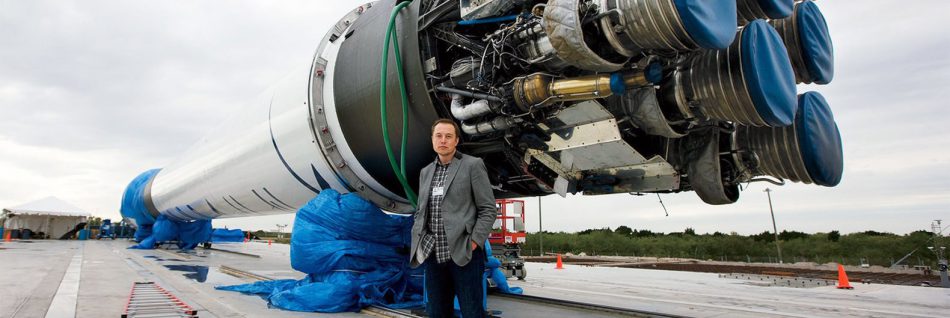
SpaceX developed the Falcon 1 and Falcon 9 launch vehicles, both of which were designed from conception to eventually become reusable, and the Dragon spacecraft, which is flown into orbit by the Falcon 9 launch vehicle to supply the International Space Station (ISS) with cargo.
SpaceX’s achievements include the first privately funded liquid-propellant rocket to reach orbit (Falcon 1 in 2008), the first private company to successfully launch, orbit, and recover a spacecraft (Dragon in 2010), the first private company to send a spacecraft to the International Space Station (Dragon in 2012), the first Vertical take-off and vertical propulsive landing for an orbital rocket (Falcon 9 in 2015), the first reuse of an orbital rocket (Falcon 9 in 2017), the first private company to launch an object into orbit around the Sun (Falcon Heavy’s payload of a Tesla Roadster in 2018), and the first private company to send astronauts to orbit and to the International Space Station (SpaceX Crew Dragon Demo-2 mission in 2020).
The launch of the SES-8 satellite for SES satellite operator, in 2013, was the first SpaceX delivery into geosynchronous orbit, while the launch of the Deep Space Climate Observatory (DSCOVR), in 2015, was the company’s first delivery beyond Earth orbit. On December 21st, 2015, SpaceX successfully returned a first stage back to a landing pad near the launch site and accomplished a propulsive vertical landing, the first such accomplishment by a rocket on an orbital trajectory. On April 8th, 2016, with the launch of CRS-8, SpaceX successfully vertically landed a first stage on an ocean drone platform and delivered Dragon to Low Earth Orbit.
SpaceX operates two drone ships; Just Read the Instructions in the Pacific Ocean for launches from Vandenberg AFB and Of Course I Still Love You in the Atlantic for launches from NASA’s Cape Canaveral AFB. As of May 2016, six Falcon 9 flights have attempted to land on a drone ship; two of them succeeded
Watch the video: ‘This is SpaceX’.
Company History
SpaceX was founded by Elon Musk late 2002. His vision was to build a simple and relatively inexpensive reusable rocket that would go into space multiple times; similar to the turnaround time capabilities that commercial airliners currently exhibit.
In 2001 Musk started the Mars Oasis project to land a miniature experimental greenhouse on Mars, containing seeds with dehydrated gel, in an attempt to regain public interest in space exploration and increase the budget of NASA. Musk realized that even with a much larger space budget, travel to Mars would still be expensive and that a fundamental breakthrough in rocket technology was needed.
In October 2001, Musk travelled to Moscow with Jim Cantrell and best friend Adeo Ressi, to buy refurbished ICBM’s (Dnepr-1) that could send the payloads into space. Musk, Cantrell and Ressi met with companies such as Lavochkin and ISC Kosmotras. In February 2002, the group returned to Russia to look for three ICBMs, bringing along Mike Griffin, who had worked for the CIA’s venture capital arm, In-Q-Tel; NASA’s Jet Propulsion Laboratory and was just leaving satellite builder Orbital ATK. The group met again with Kosmotras, and was offered one rocket for 8 million USD. However, this was seen by Musk as too expensive.
Musk realized that he could start a company that could build the affordable rockets he needed. According to early Tesla and SpaceX investor Steve Jurvetson, Musk calculated that the raw materials for building a rocket actually were only 3% of the sales price of a rocket at the time. By applying vertical integration, principally for cost reasons; around 85% of the entire Falcon/Dragon vehicle is produced in-house and the modular approach from software engineering (Falcon 9 uses 9 of the Merlin engines, which were tested on the single engine Falcon 1, Falcon Heavy uses three Falcon 9 booster stages), SpaceX could cut launch price substantially and still enjoy a 70% gross margin.
Another reason for vertical integration is that Musk thought reusable rockets couldn’t be built with components from existing suppliers that all the other aerospace companies are buying from as well. For example, SpaceX had to design a machine that could friction stir weld aluminum-lithium alloy for the airframe of the Falcon 9, because such a machine did not exist anywhere in the world. According to Musk, SpaceX started with the smallest useful orbital rocket (Falcon 1 with about half a ton to orbit), instead of building a more complex and riskier launch vehicle, which could have failed and bankrupted the company.

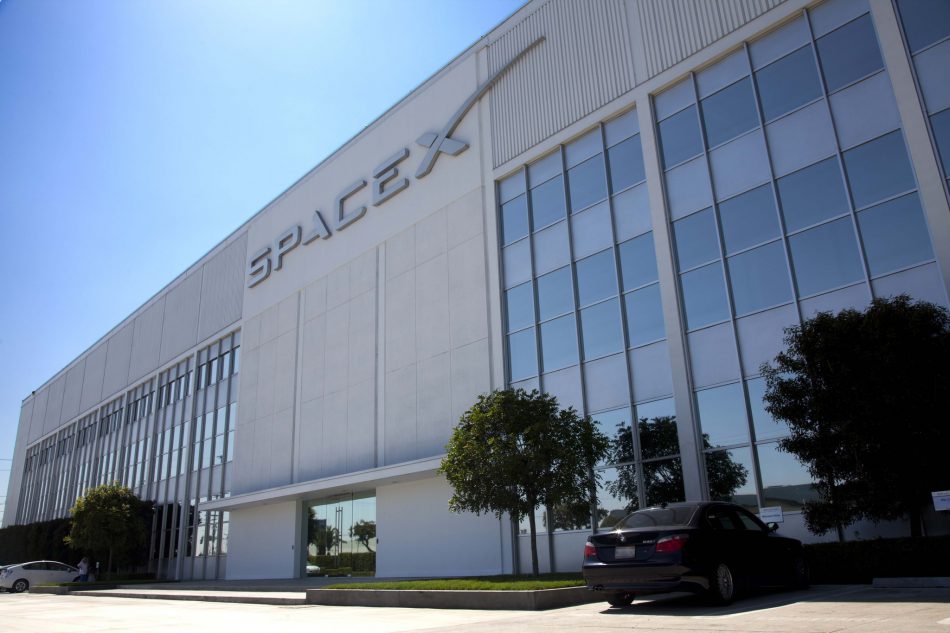
Earlier in 2002 Musk was seeking staff for his new space company, soon to be named SpaceX. Musk approached renowned rocket engineer Tom Mueller and agreed to work for Musk and SpaceX was born. SpaceX was first headquartered in a 75,000 square feet warehouse in El Segundo, California. Musk decided SpaceX’s first rocket would be named Falcon 1, a nod to Star Wars’ Millennium Falcon. The first launch for Falcon 1 was planned in November 2003, 15 months after the company started.
In January 2005, SpaceX bought a 10% stake in UK based Surrey Satellite Technology (a spin-off company of the University of Surrey and now majority-owned by Airbus Defense & Space, formerly EADS Astrium, that builds and operates small satellites) while by March 2006 Musk had invested 100 million USD of his own money into the company.
The company grew rapidly since it was founded in 2002, growing from 160 employees in November 2005 to more than 500 by July 2008, to over 1,100 in 2010, 1,800 in early 2012 and 3,000 by early 2013, nearly 5,000 in late 2015 and 8,000 in 2020.
On August 4th, 2008, Space Exploration Technologies Corp. accepted a further 20 million USD investment from Founders Fund. In early 2012, its founder owned approximately 2/3 of the company and his 70 million shares were then estimated to be worth 875 million USD on private markets, which roughly valued SpaceX at 1.3 billion USD in 2012 and 46 billion USD in 2020.
In 2008 NASA awarded the company a Commercial Orbital Transportation Services (COTS) contract, to design and demonstrate a launch system to resupply cargo to the ISS.
SpaceX, as of April 2016 has flown seven missions to the ISS under a cargo resupply contract. NASA also awarded SpaceX a contract in 2011 to develop and demonstrate a human-rated Dragon as part of its Commercial Crew Development (CCDev) program to transport crew to the ISS.
As early as 2009 the company had ambitions for ‘reusing rocket hardware’ and in October 2014 SpaceX contracted a Louisiana shipyard to build a floating landing platform for reusable orbital launch vehicles. Early information indicated that the platform would carry an approximately 90 x 50m (300 × 160ft) landing pad and would be capable of precision positioning so that the platform could hold its position for launch vehicle landing.
On May 6th, 2016, SpaceX again landed a first stage of its Falcon 9 rocket on a drone ship at sea after launching the JCSAT-14 communications satellite for Japanese satellite operator SKY Perfect JSAT.
On April 27th 2016, the Pentagon announced its decision to award an 82.7 million USD contract to SpaceX from the U.S. Air Force (USAF) to launch a next-generation GPS satellite aboard its Falcon 9 rocket in May 2018. The estimated cost was approximately 40% less than the estimated cost for previous missions.
As of March 2018, SpaceX had over 100 launches on its manifest representing about 12 billion USD in contract revenu. The contracts included both commercial and government (NASA/DOD) customers. SpaceX major competitors in the commercial satellite launch market are Arianespace, United Launch Alliance (ULA) and International Launch Services (ILS).
On 30 May 2020, SpaceX successfully launched two NASA astronauts (Doug Hurley and Bob Behnken) into orbit on a Crew Dragon spacecraft during Crew Dragon Demo-2, making SpaceX the first private company to send astronauts to the International Space Station and marking the first crewed launch from American soil in 9 years.
In July 2021 SpaceX acquired privately owned satellite Internet of Things (IoT) company Swarm Technologies, to become a whole subsidiary of SpaceX. Swarm is building a satellite constellation of about 150 small satellites in orbit and is headquartered in Paolo Alto in California USA.
On May 25th, 2022, SpaceX launched its fifth SmallSat RideShare Program mission, Transporter-5, orbiting 59 small spacecraft for various customers such as LEO satellite operators FOSSA Systems, GHGSat, ICEYE and satellite manufacturer Tyvak. The RideShare program provides cost-effective launches by allowing customers to share a ride atop previously-flown rockets for a base price of 1.1 million USD per each payload that weighs 200kgs. The Transporter-5 mission launched a variety of payloads ranging from CubeSats to orbital transfer vehicles with small satellites. The mission carried a couple of interesting payloads, including an in-orbit metal cutting robot created by Nanorachs/Maxar Technologies and a Celestis satellite carrying the cremated remains of 47 people.
In December 2022 SpaceX introduced its Starshield business to support national security efforts. Starshield has three focus areas;
- Earth Observation, with satellites with sensing payloads to collect data,
- Communications,
- Hosted payloads with satellite buses to support customer missions.
This is the first indication of SpaceX having an Earth observation and hosted payload offering.
On January 3rd, 2023 SpaceX kicked-off its first launch with their Transporter-6 RideShare mission with 110 SmallSats. The Falcon 9 upper stage released 114 payloads into SSO an hour after liftoff, a process involving 82 individual deployments. The largest single customer on this mission, was Earth Observation company Planet, which had 36 of its SuperDove imaging satellites on board.
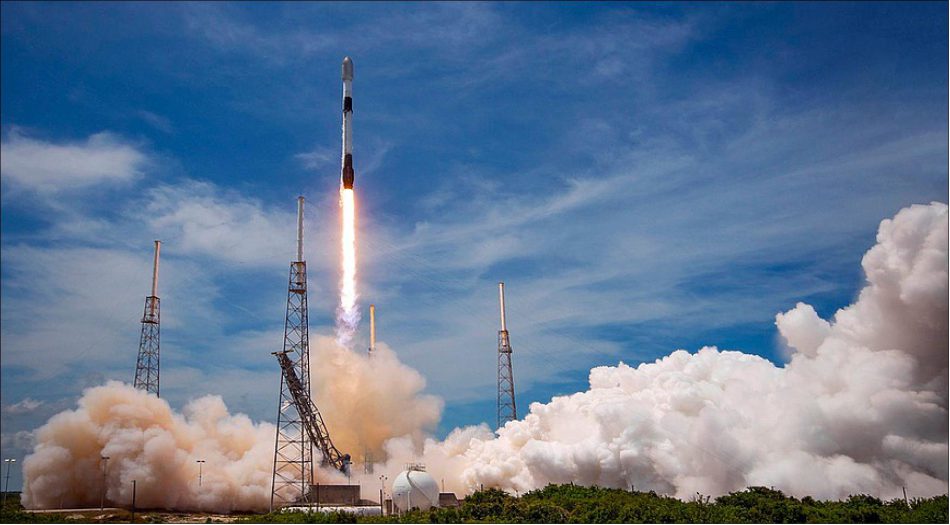
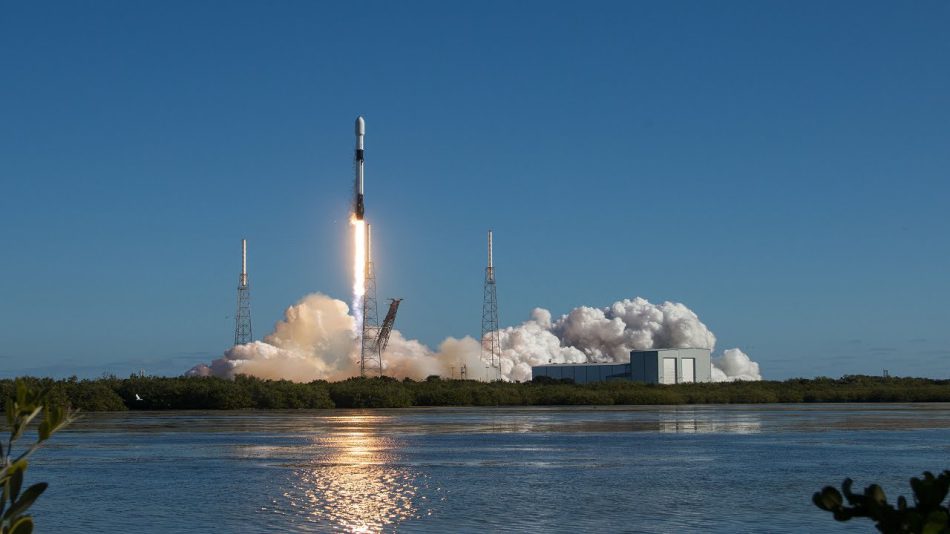
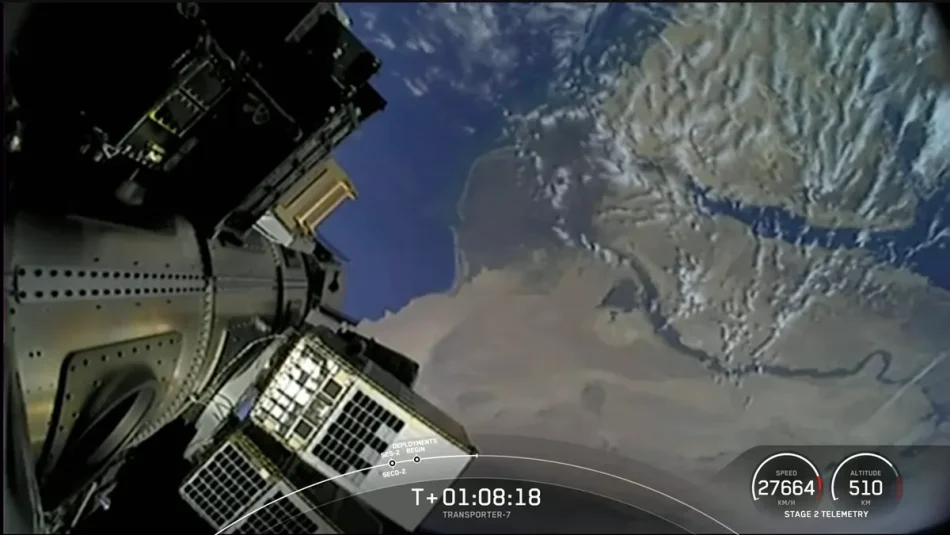
On April 15th, 2023 SpaceX launched the Transporter-7 RideShare mission on a Falcon 9 rocket, its 23rd mission of the year. The launch carried 51 payloads and was the first in SpaceX’s series of Transporter dedicated SmallSat rideshare missions to launch from Vandenberg launch base in California, after the first six launched from Cape Canaveral in Florida.
On April 20th, 2023 SpaceX’s Starship rocket cleared its launch platform but failed to separate from its booster, exploding four minutes after liftoff during an inaugural test flight. The 400ft tall uncrewed spacecraft was planned to fly fora 90-minute trip around the Earth before a splashdown near Hawaii. After reaching orbit, the rocket began to spin in the air and exploded.
Reusable rockets
SpaceX has been attempting to perfect the autonomous landing and recovery of the first stage of the Falcon 9 launch vehicle, with three successes out of seven attempts. As a result of Elon Musk’s goal of crafting more cost-effective launch vehicles, SpaceX conceived a method to reuse the first stage of their primary rocket, the Falcon 9, by attempting propulsive vertical landings on solid surfaces.
Once the company determined that soft landings were feasible by touching down over the Atlantic and Pacific Ocean, they began landing attempts on a solid platform. SpaceX leased and modified several barges to sit out at sea as a target for the returning first stage, converting them to Autonomous Spaceport Drone Ships (ASDS).
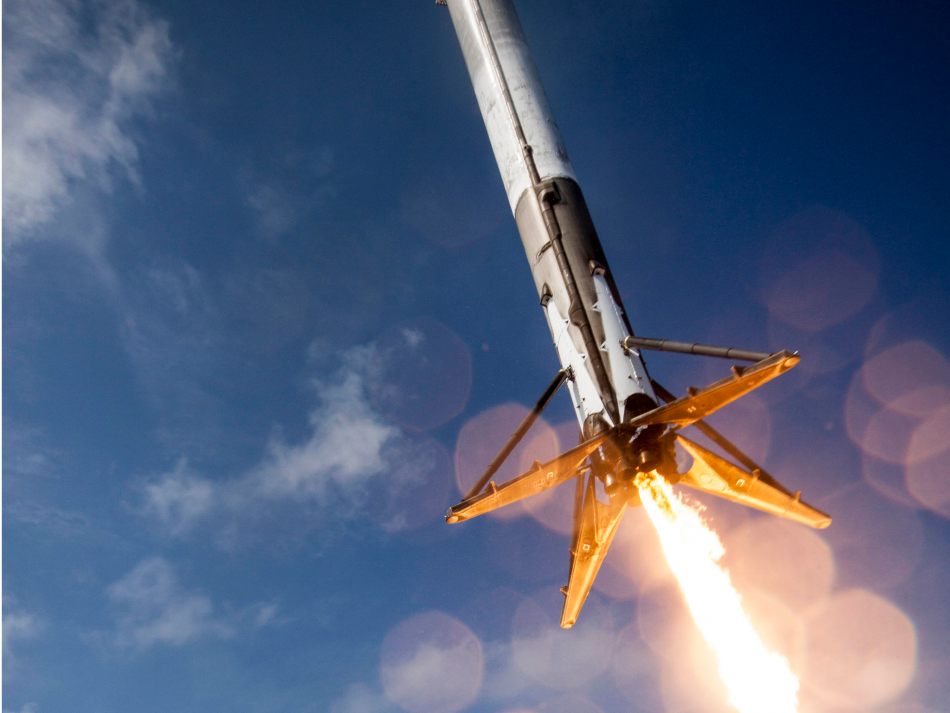
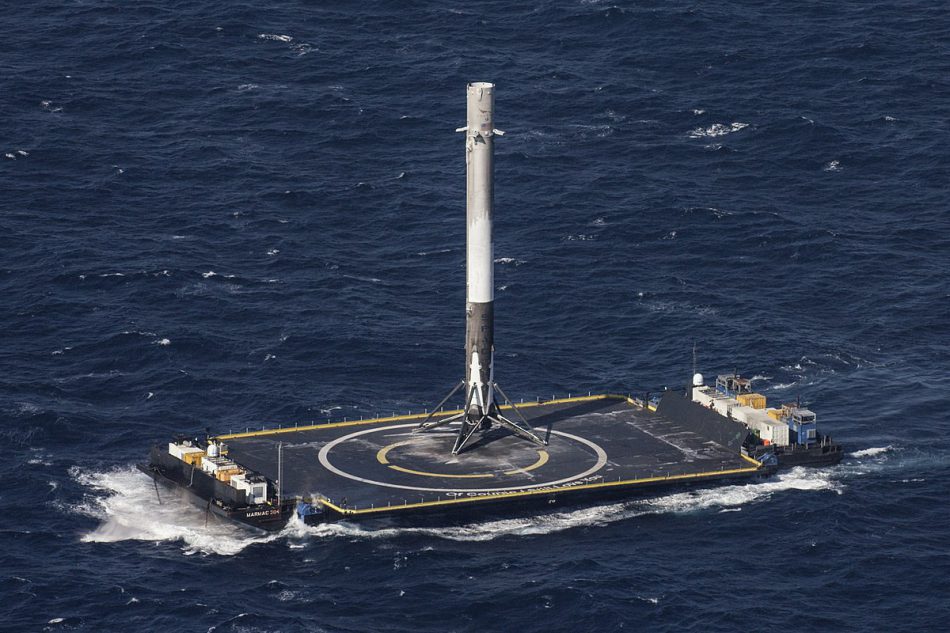
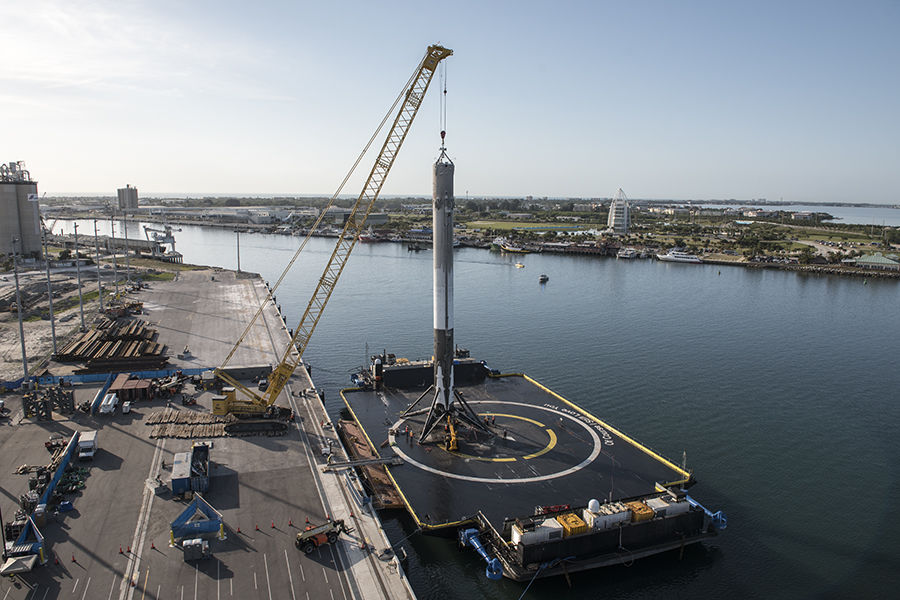
On January 10th, 2015 CRS-5 (Commercial Resupply Service 5), launched with the rocket stage set to be the first to land on a solid surface and be recovered intact. The spacecraft made it to the ASDS, though it came in too fast and at an angle, exploding on the surface of the ship and scattering debris on its surface and in the ocean. The drone ship experienced some structural damages, but nothing irreparable. The cause of the failed landing was determined a failure of the grid fins used on the craft during the descent to stabilize it, which ran out of hydraulic fluid and ceased to function properly.
SpaceX’s next attempt, December 21st, 2015, successfully landed the first stage for the first time for an orbital launch, landing the first stage booster from their 2nd mission for Orbcomm at Landing Zone 1 at Kennedy Space Center (a Return To Launch Site landing).
In January 2016 another ASDS landing attempt was made during the launch of the Jason-3 satellite, for EUMETSAT, from Vandenberg AFB in California. The stage successfully touched down on the drone ship ‘Just read the Instructions’, landing 1.3m from the center of the painted target at a suitable speed. However, a landing leg collet failed to lock, and the stage again tipped over and destroyed the rocket. The leg collet failure was attributed to frozen condensation from fog prior to launch.
On April 8th, 2016, the first stage booster successfully landed on the ASDS ‘Of Course I Still Love You’, marking the first time SpaceX successfully landed and recovered an orbitally launched rocket at the Atlantic Ocean.
On May 6th, 2016, SpaceX landed the first stage of the Falcon 9 on ‘Of Course I Still Love You’ during the JCSAT-14 mission of SKY Perfect JSat satellite operator of Japan, its 2nd time successfully landing on the drone ship at sea. This was the first time a booster on a GEO Stationary satellite launch landed successfully.
Starlink Satellite Constellation
Since 2015 SpaceX is constructing Starlink satellite internet constellation providing satellite Internet access. The constellation will consist of thousands of mass-produced small satellites in low Earth orbit (LEO), working in combination with ground transceivers. Starlink satellite constellation will deliver high speed broadband internet to locations where access has been unreliable, expensive or completely unavailable.
Each satellite weighs approximately 260kgs and features a compact, flat panel design that maximizes volume, allowing for a diverse launch stack on SpaceX Falcon 9 rocket. The total cost of the decade-long project to design, build and deploy the constellation was estimated by SpaceX to be about 10 billion USD.
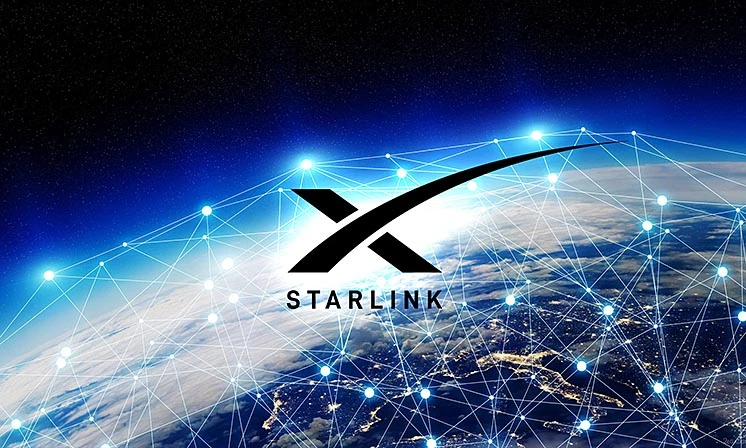
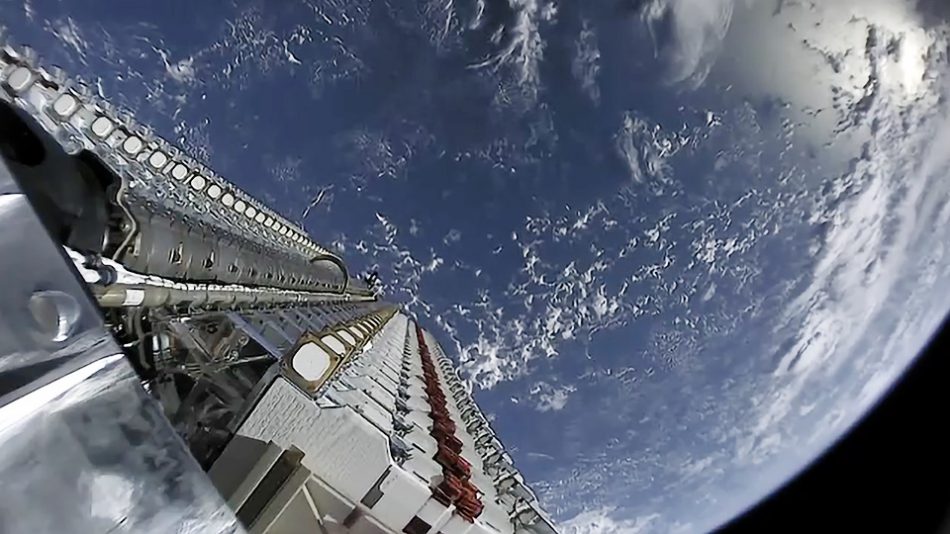
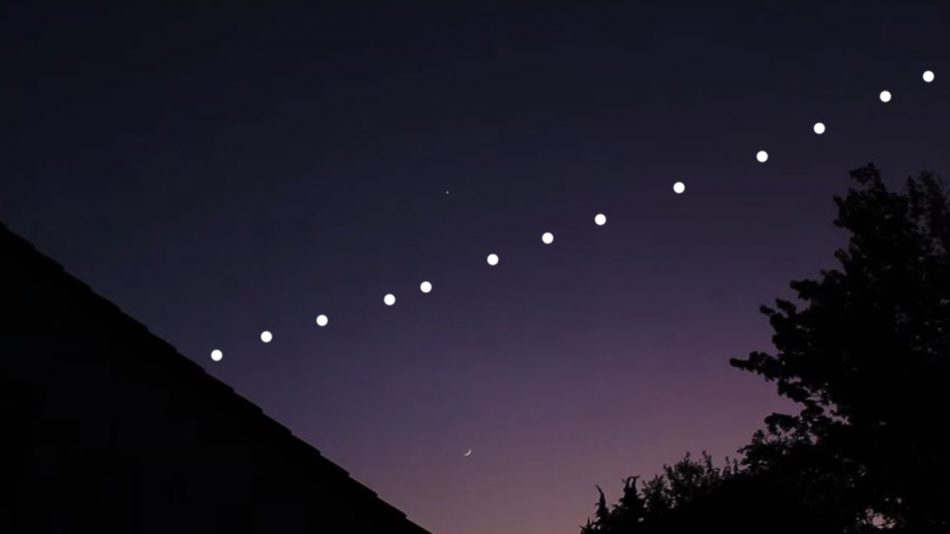
In August 2018, SpaceX consolidated all their Seattle-area operations with a move to a larger three-building facility in Redmond, Washington to support satellite manufacturing and R&D.
With over 5,000 LEO satellites in orbit, Starlink has become accessible in over 50 countries, with Kenya, the Philippines, and Zambia among the nations that have received access in 2023.
SpaceX Facilities & Launch sites
SpaceX is headquartered in the Los Angeles suburb of Hawthorne California. The large three-story facility, houses SpaceX’s office space, mission control, and vehicle factory. The area has one of the largest concentrations of aerospace headquarters, facilities, and/or subsidiaries in the USA, including Boeing/McDonnell Douglas main satellite buildings, NASA’s Jet Propulsion Laboratory, Lockheed Martin, BAE Systems, Northrop Grumman, etc., with a large pool of aerospace engineers and recent college engineering graduates.
SpaceX utilizes a high degree of vertical integration in the production of its rockets and rocket engines. Unusually for the aerospace industry, SpaceX builds its rocket engines, rocket stages, spacecraft, principal avionics and all software in-house in their Hawthorne facility. Nevertheless, SpaceX still has over 3,000 suppliers with some 1,100 of those delivering to SpaceX nearly weekly.
SpaceX maintains launch sites at Cape Canaveral Air Force Station (CCAFS), Kennedy Space Center (KSC) in Florida, Vandenberg Air Force Base (VAFB) in California, and Boca Chica, Texas:
Cape Canaveral Air Force Station, Space Launch Complex 40 in Florida
The site’s location on the southeast coast of the US provides access to a wide range of low and medium inclination orbits frequently used by communications and Earth-observing satellites and by supply missions to the International Space Station. The site also allows access to geostationary orbits, as well as departures to the Moon and interplanetary destinations. Situated on Cape Canaveral Air Force Station, with Patrick Air Force Base to the south and NASA’s Kennedy Space Center to the north, SLC-40 benefits from many support services in the region, including security and launch range control, weather monitoring, ground support infrastructure, payload processing facilities, and long-range tracking cameras capable of observing launches from liftoff through stage separation and second-stage ignition out over the Atlantic.
Kennedy Space Center, Space Launch Complex 39A in Florida
SpaceX is modifying Kennedy Space Center’s historic Space Launch Complex 39A, home of the Apollo and Space Shuttle programs, for flights of the Falcon 9 and Falcon Heavy rocket. In addition to commercial satellite launches and space station resupply missions, LC-39A will support crewed launches of the Dragon spacecraft for NASA. Once operational, LC-39A will have a hangar, a payload processing annex, and a transporter-erector, along with modifications to the existing crawler way, the fixed and rotating service structures, and pad deck. As with LC-40, LC-39A benefits from many local support services including security and launch range control, weather monitoring, ground support infrastructure, payload processing facilities, and long-range tracking cameras.
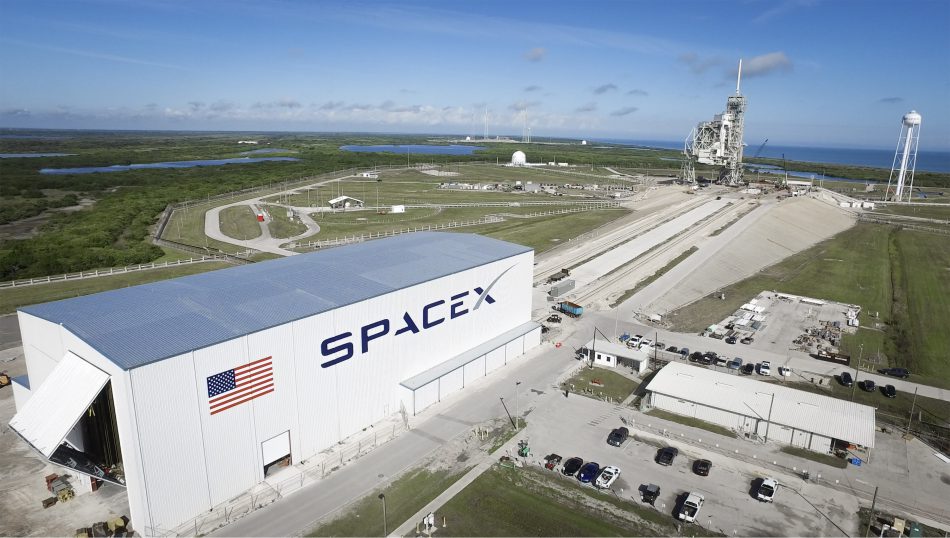
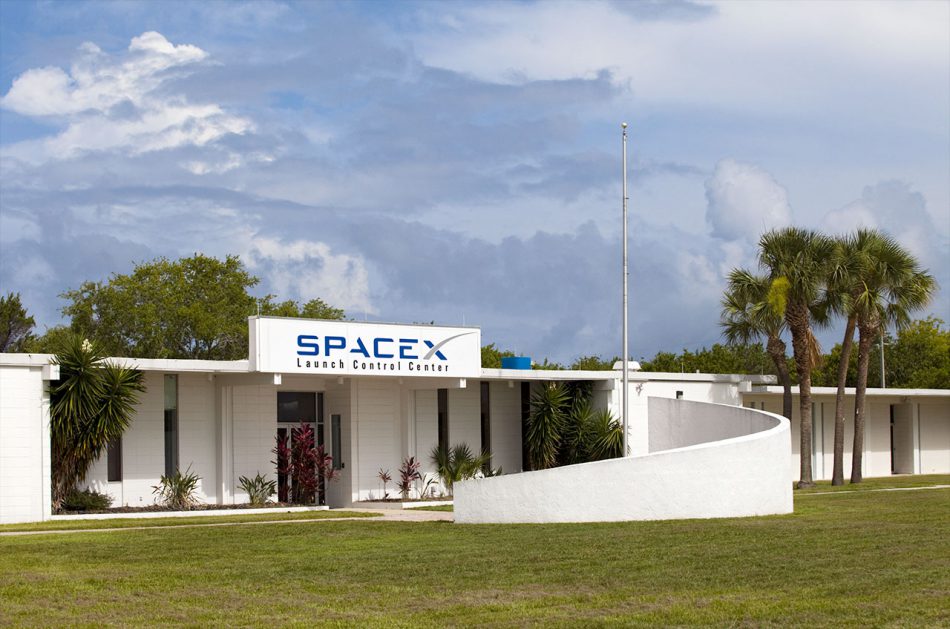
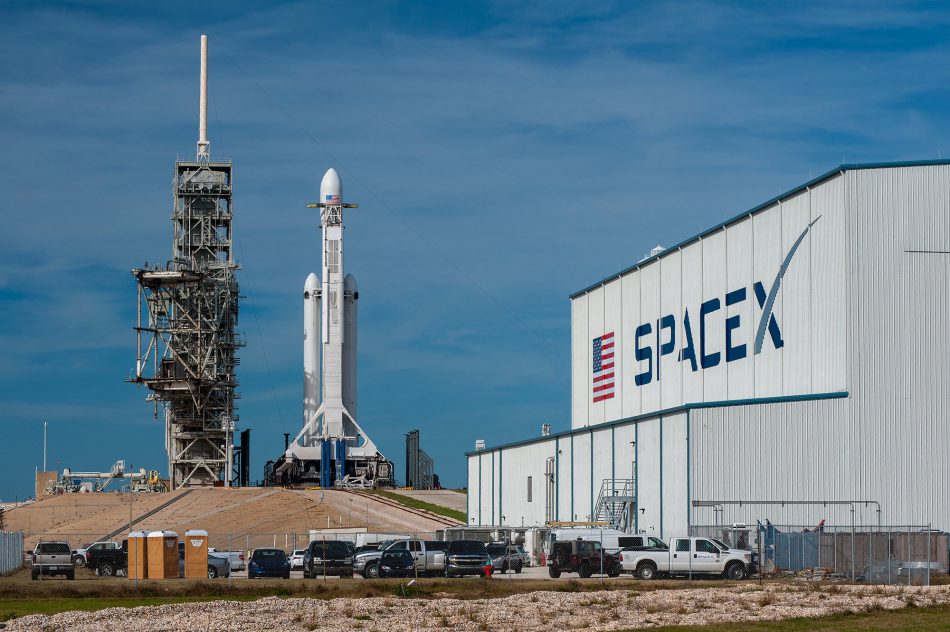
Vandenberg Air Force Base, Space Launch Complex 4 East in California
The site’s location on the California coastline provides customers with access to high inclination and polar orbits, frequently used by satellite communication constellations, defense intelligence and Earth-observing satellites, and some lunar missions. Launches from Vandenberg heading straight south traverse Open Ocean all the way to the Antarctic, by which time the vehicles have long since reached orbit. SpaceX’s operations at SLC-4E benefit from Vandenberg‘s security and launch range control, weather monitoring, ground support infrastructure, payload processing facilities, and long-range tracking cameras capable of observing launches from liftoff through stage separation and second-stage ignition over the Pacific.
SpaceX South Texas Launch Site in Texas
SpaceX is building the world’s first commercial launch site designed for orbital missions in the Boca Chica area of South Texas. The site’s southern, coastal location is uniquely optimized for orbital space launches from the continental United States, it is as close to the equator as possible, while remaining distanced from populated areas. SpaceX South Texas will be optimized for commercial launches, and will support launches of the Falcon 9 and Falcon Heavy to low-Earth orbit, geostationary orbit, and beyond.
Launch Vehicles
Dragon
The Dragon is a free-flying spacecraft designed to deliver both cargo and people to orbiting destinations. Dragon made history in 2012 when it became the first commercial spacecraft in history to deliver cargo to the ISS and safely returned cargo to Earth, a feat previously achieved only by governments. It is the only spacecraft currently flying that is capable of returning significant amounts of cargo back to Earth. Currently Dragon carries cargo to space, but it was designed from the beginning to carry humans. Under an agreement with NASA, SpaceX is now developing the refinements that will enable Dragon to fly crew. Dragon’s first manned test flight is expected to take place in 2-3 years.
Falcon 9
The Falcon 9 is a two-stage rocket designed and manufactured by SpaceX for the reliable and safe transport of satellites and the Dragon spacecraft into orbit. As the first rocket completely developed in the 21st century, Falcon 9 was designed from the ground up for maximum reliability. Falcon 9’s simple two-stage configuration minimizes the number of separation events — and with nine first-stage engines, it can safely complete its mission even in the event of an engine shutdown.
The Falcon 9 made history in 2012 when it delivered Dragon into the correct orbit for rendezvous with the International Space Station, making SpaceX the first commercial company ever to visit the station. Since then SpaceX has made multiple flights to the space station, both delivering and returning cargo for NASA. Falcon 9, along with the Dragon spacecraft, was designed from the outset to deliver humans into space and under an agreement with NASA, SpaceX is actively working towards that goal.
Falcon Heavy
When Falcon Heavy lifted off in late 2016, it was the most powerful operational rocket in the world by a factor of two. With the ability to lift into orbit over 54 metric tons (119,000 lbs), a mass equivalent to a 737 jetliner loaded with passengers, crew, luggage and fuel. Falcon Heavy can lift more than twice the payload of the next closest operational vehicle, the Delta IV Heavy, at one-third the cost.
Falcon Heavy draws upon the proven heritage and reliability of Falcon 9. Its first stage is composed of three Falcon 9 nine-engine cores whose 27 Merlin engines together generate more than 5 million pounds of thrust at liftoff, equal to approximately eighteen 747 aircraft. Only the Saturn V moon rocket, last flown in 1973, delivered more payloads to orbit. Falcon Heavy was designed from the outset to carry humans into space and restores the possibility of flying missions with crew to the Moon or Mars.
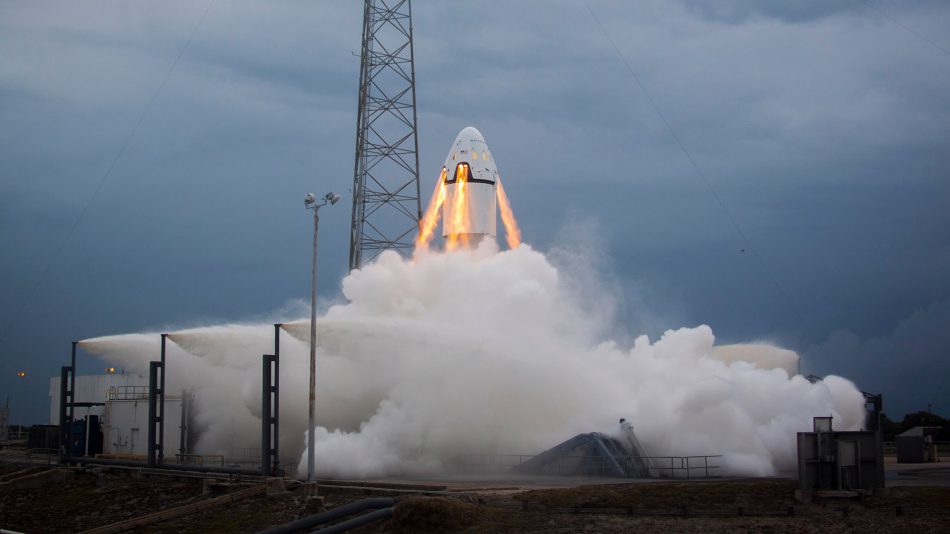
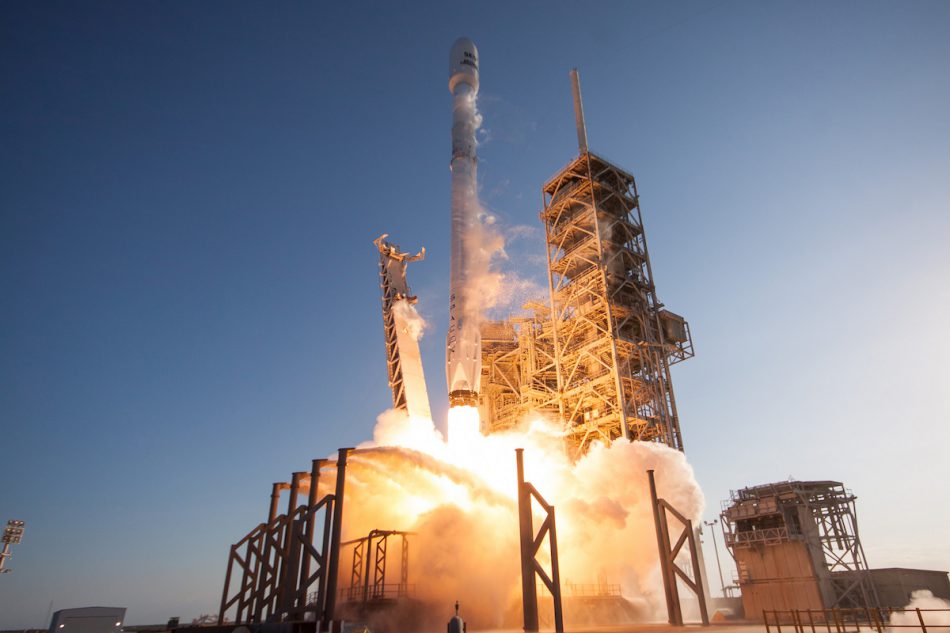

Launch market competition and pricing pressure
SpaceX’s low launch prices (less than 2,500 USD per pound to orbit for Falcon 9 v1.1 and 1,000 USD for Falcon Heavy), especially for communication satellites flying to geostationary (GTO) orbit, have resulted in market pressure on the competition to lower their own prices. The communications satellites launch market had been dominated in the years preceding 2013 by launch operators Arianespace with the Ariane 5, International Launch Services (ILS) with their Proton vehicle, United Launch Alliance (ULA) with Atlas and Delta launchers and Sea Launch with their Zenit-3SL launch system from sea.
By late 2013, with a published price of 56.5 million USD per launch to low Earth orbit SpaceX Falcon 9 rockets were already the cheapest in the industry. Reusable Falcon 9s could drop the price by an order of magnitude, sparking more space-based enterprise, which in turn would drop the cost of access to space still further through economies of scale.
SpaceX capabilities and prices are affecting the global market considerably. European launch operator Arianespace requested in early 2014 that European governments provide additional subsidies to face the competition from SpaceX. ESA is pushed by European satellite operators to reduce Ariane 5 and the future Ariane 6 rocket launch prices as a result of competition from SpaceX. This results in company restructurings and consolidations.
By November 2014 SpaceX took already market share from Arianespace. In 2014, Falcon 9 GTO mission pricing was approximately 15 million USD less than a launch on the Chinese Great Wall Industry company (CASTC) built Long March 3B rocket. However, the Chinese Government made a policy decision to maintain satellite launch prices at approximately 70 million USD. SpaceX capabilities and lower launch prices have also begun to affect the market for launch of US military payloads, where for nearly a decade launch operator United Launch Alliance (ULA) had faced no competition for the military launches. In October 2014 ULA announced a major restructuring of processes and workforce in order to decrease launch costs by half, in part as a result of competition from SpaceX.
In May 2015, ULA stated that it would go out of business unless it won commercial and civil satellite launch orders to offset an expected slump in U.S. military and spy launches. Jean Botti, Director of innovation for Airbus (which makes the Ariane 5) warned that “those who don’t take Elon Musk and SpaceX seriously will have a lot to worry about.”
When the final numbers were in for 2014, SpaceX had won nine contracts out of 20 that were competed worldwide in 2014 at commercial launch service providers. This was the first year in some time that no commercial launches were booked on the Russian (Proton) and Russian-Ukrainian (Zenit) launch service providers. SpaceX launched their first communication satellite to geosynchronous orbit only in late 2013.
SpaceX has publicly indicated that if they are successful with developing the reusable technology, launch prices in the 5 to 7 million USD range for the reusable Falcon 9 are possible.
All trademarks, logos and images mentioned and showed on this page are property of their respective owners.
Resources
www.spacex.com
www.starlink.com
www.wikipedia.org
www.spacexstats.com
www.nasa.gov
www.space.com edition May 6th 2016
www.spacenews.com edition September 1st 2016
www.theverge.com edition December 15th 2017
www.theatlantic.com edition December 26th 2017
www.spacexfleet.com
www.spaceflightnow.com edition August 18th 2020
www.techcrunch.com edition August 18th 2020
www.theverge.com edition February 6th 2020
www.satellitetoday.com edition August 9th, 2021
www.spaceflight101.com
www.swarm.space
www.tesmanian.com edition May 25th, 2022
www.satellitetoday.com edition December 5th, 2022
www.spacenews.com January 3rd, 2023
www.spacenews.com April 15th, 2023
www.npr.org edition April 20th, 2023

Supplier
SpaceX
SpaceX, Inc.
Rocket Road
CA 90250 Hawthorne
USA
Satellites launched by SpaceX
| Spacecraft | Country | |||
| ABS-2A (Mongolsat-1)GEO | 75° East | Asia Broadcast Satellite (ABS) |  | Communication |
| ABS-3AGEO | 3° West | Asia Broadcast Satellite (ABS) |  | Communication |
| Amazonas Nexus (IS-46)GEO | 61° West | Hispasat |  | Communication |
| AMOS 17GEO | 17° East | Spacecom |  | Communication |
| AMOS-6GEO | - | Spacecom |  | Communication |
| ANASIS-2 (KMilSatCom-1, Koreasat-116)GEO | 116.2° East | Korean Agency for Defense Development (ADD) |  | Military & Intelligence |
| ArabSat-6AGEO | 30.5° East | Arabsat |  | Communication |
| ArabSat-7AGEO | 30.5° East | Arabsat |  | Communication |
| Arcturus (Aurora-4A)MicroGEO | 163° West | Astranis |  | Communication |
| ASBM-1 (GX-10A, EPS-R 1)HEO | 65° North | Space Norway (former Telenor Satellite Services) |  | Communication |
| ASBM-2 (GX-10B, EPS-R 2)HEO | 65° North | Space Norway (former Telenor Satellite Services) |  | Communication |
| AsiaSat-6/Thaicom-7GEO | 120° East | AsiaSat |  | Communication |
| AsiaSat-8 (AMOS 7)GEO | 4° West | AsiaSat |  | Communication |
| Astra 1P/SES-24GEO | 19° East | SES |  | Broadcasting |
| BADR-8 (ArabSat-7B)GEO | 26° East | Arabsat |  | Communication |
| Bangabandhu-1GEO | 119° East | BSCL |  | Communication |
| BulgariaSat-1GEO | 2° East | Bulgaria Sat |  | Communication |
| Dror-1 (PR-8000)GEO | GTO | State of Israel |  | Communication |
| EchoStar XXIII (EchoStar-23)GEO | 68° West | EchoStar |  | Communication |
| EchoStar XXIV (Jupiter-3, EchoStar-24, HNS-95W)GEO | 105° West | EchoStar |  | Communication |
| Es’hail-2GEO | 26° East | Es'hailSat |  | Communication |
| Eutelsat 10BGEO | 10° East | Eutelsat |  | Communication |
| Eutelsat 115 West B (SatMex 7)GEO | 115° West | Eutelsat |  | Communication |
| Eutelsat 117 West B (SatMex 9)GEO | 117° West | Eutelsat |  | Communication |
| Eutelsat 13F (HOTBIRD 13F)GEO | 13° East | Eutelsat |  | Communication |
| Eutelsat 13G (HOTBIRD 13G)GEO | 13° East | Eutelsat |  | Communication |
| Eutelsat 36DGEO | 7° East | Eutelsat |  | Communication |
| Galaxy-31 (G-31)GEO | 121° West | Intelsat |  | Communication |
| Galaxy-32 (G-32)GEO | 91° West | Intelsat |  | Communication |
| Galaxy-33 (G-33)GEO | 133° West | Intelsat |  | Communication |
| Galaxy-34 (G-34)GEO | 129° West | Intelsat |  | Communication |
| Galaxy-37 (Horizons-4)GEO | 127° West | Intelsat |  | Communication |
| GOES-U (GOES-19)GEO | 75.2° West | National Oceanic and Atmospheric Administration (NOAA) |  | Weather Forecasting |
| GSAT-20 (GSAT-N2, CMS-03)GEO | 68° East | NewSpace India |  | Communication |
| Hispasat 30W-6GEO | 30° West | Hispasat |  | Communication |
| Inmarsat-5 F4 (Inmarsat GX4) (In-orbit Spare)GEO | 6° East (In-orbit Spare) | Inmarsat |  | Communication |
| Inmarsat-6 F2 (Inmarsat GX6B, I-6 F2)GEO | 28° West | Inmarsat |  | Communication |
| Intelsat-35e (IS-35e)GEO | 325.5° East | Intelsat |  | Communication |
| Intelsat-40e/TEMPO (IS-40e)GEO | 91° West | Intelsat |  | Communication |
| JCSAT-16GEO | 162° East | SKY Perfect JSAT |  | Communication |
| JCSAT-2b (JCSAT-14)GEO | 154° East | SKY Perfect JSAT |  | Communication |
| Kacific-1/JCSAT-18GEO | 150° East | Kacific |  | Communication |
| KoreaSat-5A (Mugunghwa-5A)GEO | 113° East | KT Sat |  | Communication |
| KoreaSat-6A (Mugunghwa-6A)GEO | 116° East | KT Sat |  | Communication |
| Merah Putih 2 (HTS-113BT)GEO | 113° East | Telkomsat |  | Communication |
| MTG-S1 (Meteosat-13, Sentinel-4A)SmallGEO | 0.0° West | EUMETSAT |  | Weather Forecasting |
| NileSat-301GEO | 7° West | Nilesat |  | Communication |
| Nusantara Lima (Nusantara 5)GEO | 113° East | Pasifik Satelit Nusantara (PSN) |  | Communication |
| Nusantara Satu (Nusantara 1 / PSN 6)GEO | 146° East | Pasifik Satelit Nusantara (PSN) |  | Communication |
| Nusantara Tiga (SATRIA-1)GEO | 146° East | Pasifik Satelit Nusantara (PSN) |  | Communication |
| NuView Alpha (Anuvu-1)MicroGEO | 7° East | Anuvu |  | Communication |
| NuView Bravo (Anuvu-2)MicroGEO | 7° East | Anuvu |  | Communication |
| Optus-X (TD7)GEO | 87.75° East | Optus Australia |  | Military & Intelligence |
| Ovzon-3MicroGEO | 60° East | Ovzon |  | Communication |
| SES-10GEO | 67° West | SES |  | Communication |
| SES-11/EchoStar-105GEO | 105° West | EchoStar |  | Communication |
| SES-12GEO | 95° East | SES |  | Communication |
| SES-16/GovSat-1GEO | 21.5° East | GovSat |  | Communication |
| SES-18GEO | 103° West | SES |  | Communication |
| SES-19GEO | 135° West | SES |  | Communication |
| SES-22GEO | 135° West | SES |  | Communication |
| SES-9GEO | 108.2° East | SES |  | Communication |
| SpainSat-NG1GEO | 30° East | HisdeSat Servicios Estratégicos S.A. |  | Military & Intelligence |
| SpainSat-NG2GEO | 29° East | HisdeSat Servicios Estratégicos S.A. |  | Military & Intelligence |
| SXM-10GEO | 116.2° West | SiriusXM |  | Broadcasting |
| SXM-7GEO | 85° West | SiriusXM |  | Broadcasting |
| SXM-8GEO | 85° West | SiriusXM |  | Broadcasting |
| SXM-9GEO | 85° West | SiriusXM |  | Broadcasting |
| Telkom-4 (Merah Putih)GEO | 108° East | Telkomsat |  | Communication |
| Telstar-18V (APSTAR-5C)GEO | 138° East | Telesat |  | Communication |
| Telstar-19V (Telstar 19 Vantage)GEO | 63° West | Telesat |  | Communication |
| Thaicom-8GEO | 78.5° East | Thaicom |  | Communication |
| Thaicom-9GEO | 119.5° East | Thaicom |  | Communication |
| Thuraya-4 NGSGEO | 98.5° East | Space42 (aka Yahsat) |  | Communication |
| TürkmenÄlem 52°E/MonacoSatGEO | 52° East | JSC Turkmen Hemrasy |  | Communication |
| TürkSat-5aGEO | 31° East | Türksat |  | Communication |
| TürkSat-5bGEO | 42° East | Türksat |  | Communication |
| TürkSat-6aSmallGEO | 42° East | Türksat |  | Communication |
| Viasat-3 Americas (VS-3 Americas)GEO | 89° West | Viasat, Inc. |  | Communication |

Supplier
SpaceX
SpaceX, Inc.
Rocket Road
CA 90250 Hawthorne
USA
Rideshare missions by SpaceX
| Rideshare Mission | Launch date | Launch vehicle | Spacecraft launched | Orbit |
| Starlink-346 (Group 6-98) | 13 January 2026 | Falcon 9 | 28 | LEO |
| Starlink-345 (Group 6-97) | 10 January 2026 | Falcon 9 | 29 | LEO |
| Starlink-344 (Group 6-96) | 8 January 2026 | Falcon 9 | 29 | LEO |
| Starlink-343 (Group 6-88) | 4 January 2026 | Falcon 9 | 28 | LEO |
| Starlink-342 (Group 15-13) | 17 December 2025 | Falcon 9 | 27 | LEO |
| Starlink-341 (Group 6-99) | 17 December 2025 | Falcon 9 | 29 | LEO |
| Starlink-340 (Group 6-82) | 15 December 2025 | Falcon 9 | 29 | LEO |
| Starlink-339 (Group 15-12) | 14 December 2025 | Falcon 9 | 27 | LEO |
| Starlink-338 (Group 6-90) | 11 December 2025 | Falcon 9 | 29 | LEO |
| Starlink-337 (Group 15-11) | 10 December 2025 | Falcon 9 | 27 | LEO |
| Starlink-336 (Group 6-92) | 7 December 2025 | Falcon 9 | 29 | LEO |
| Starlink-335 (Group 11-15) | 7 December 2025 | Falcon 9 | 28 | LEO |
| Starlink-334 (Group 11-25) | 4 December 2025 | Falcon 9 | 28 | LEO |
| Starlink-333 (Group 6-95) | 2 December 2025 | Falcon 9 | 29 | LEO |
| Starlink-332 (Group 6-86) | 1 December 2025 | Falcon 9 | 29 | LEO |
| Starlink-331 (Group 15-10) | 30 November 2025 | Falcon 9 | 27 | LEO |
| Transporter-15 | 28 November 2025 | Falcon 9 | 125 | SSO |
| Starlink-330 (Group 11-30) | 23 November 2025 | Falcon 9 | 28 | LEO |
| Starlink-329 (Group 6-79) | 22 November 2025 | Falcon 9 | 29 | LEO |
| Starlink-328 (Group 6-78) | 21 November 2025 | Falcon 9 | 29 | LEO |
| Starlink-327 (Group 6-94) | 19 November 2025 | Falcon 9 | 29 | LEO |
| Starlink-326 (Group 6-85) | 15 November 2025 | Falcon 9 | 29 | LEO |
| Starlink-325 (Group 6-89) | 15 November 2025 | Falcon 9 | 29 | LEO |
| Starlink-324 (Group 6-87) | 10 November 2025 | Falcon 9 | 29 | LEO |
| Starlink-323 (Group 10-51) | 8 November 2025 | Falcon 9 | 29 | LEO |
| Starlink-322 (Group 11-14) | 6 November 2025 | Falcon 9 | 28 | LEO |
| Starlink-321 (Group 6-81) | 6 November 2025 | Falcon 9 | 29 | LEO |
| Bandwagon-4 | 2 November 2025 | Falcon 9 | 21 | SSO |
| Starlink-320 (Group 11-23) | 31 October 2025 | Falcon 9 | 28 | LEO |
| Starlink-319 (Group 10-37) | 29 October 2025 | Falcon 9 | 29 | LEO |
| Starlink-318 (Group 11-21) | 28 October 2025 | Falcon 9 | 28 | LEO |
| Starlink-317 (Group 10-21) | 26 October 2025 | Falcon 9 | 28 | LEO |
| Starlink-316 (Group 11-12) | 25 October 2025 | Falcon 9 | 28 | LEO |
| Starlink-315 (Group 11-5) | 22 October 2025 | Falcon 9 | 28 | LEO |
| Starlink-314 (Group 11-19) | 19 October 2025 | Falcon 9 | 28 | LEO |
| Starlink-313 (Group 10-17) | 19 October 2025 | Falcon 9 | 28 | LEO |
| SDA T1TL-C | 16 October 2025 | Falcon 9 | 21 | LEO |
| Starlink-312 (Group 10-52) | 16 October 2025 | Falcon 9 | 28 | LEO |
| Kuiper-6 (KF-03) | 13 October 2025 | Falcon 9 | 24 | LEO |
| Starlink-311 (Group 11-17) | 8 October 2025 | Falcon 9 | 28 | LEO |
| Starlink-310 (Group 10-59) | 7 October 2025 | Falcon 9 | 28 | LEO |
| Starlink-309 (Group 11-39) | 3 October 2025 | Falcon 9 | 28 | LEO |
| Starlink-308 (Group 11-20) | 28 September 2025 | Falcon 9 | 28 | LEO |
| Starlink-307 (Group 17-11) | 26 September 2025 | Falcon 9 | 24 | LEO |
| Starlink-306 (Group 10-15) | 25 September 2025 | Falcon 9 | 28 | LEO |
| IMAP | 24 September 2025 | Falcon 9 | 3 | LEO |
| NROL-48 | 22 September 2025 | Falcon 9 | 17 | LEO |
| Starlink-305 (Group 10-27) | 21 September 2025 | Falcon 9 | 28 | LEO |
| Starlink-304 (Group 17-12) | 19 September 2025 | Falcon 9 | 24 | LEO |
| Starlink-303 (Group 10-61) | 18 September 2025 | Falcon 9 | 28 | LEO |
| Cygnus NG-23 (SpX-23) | 15 September 2025 | Falcon 9 | 1 | LEO |
| Starlink-302 (Group (17-10) | 13 September 2025 | Falcon 9 | 24 | LEO |
| SDA T1TL-B | 10 September 2025 | Falcon 9 | 21 | LEO |
| Starlink-301 (Group 17-9) | 6 September 2025 | Falcon 9 | 24 | LEO |
| Starlink-300 (Group 10-57) | 5 September 2025 | Falcon 9 | 28 | LEO |
| Starlink-299 (Group 10-22) | 3 September 2025 | Falcon 9 | 28 | LEO |
| Starlink-298 (Group 17-8) | 3 September 2025 | Falcon 9 | 24 | LEO |
| Starlink-297 (Group 10-14) | 31 August 2025 | Falcon 9 | 28 | LEO |
| Starlink-296 (Group 17-7) | 30 August 2025 | Falcon 9 | 24 | LEO |
| Starlink-295 (Group 10-11) | 28 August 2025 | Falcon 9 | 28 | LEO |
| Starlink-294 (Group 10-56) | 27 August 2025 | Falcon 9 | 28 | LEO |
| NAOS | 26 August 2025 | Falcon 9 | 8 | LEO |
| CRS-33 (SpX-33) | 24 August 2025 | Falcon 9 | 6 | LEO |
| Starlink-293 (Group 17-6) | 22 August 2025 | Falcon 9 | 24 | LEO |
| Starlink-292 (Group (17-5) | 18 August 2025 | Falcon 9 | 24 | LEO |
| Starlink-291 (Group 10-20) | 14 August 2025 | Falcon 9 | 28 | LEO |
| Starlink-290 (Group 17-4) | 14 August 2025 | Falcon 9 | 24 | LEO |
| Kuiper-4 (KF-02) | 11 August 2025 | Falcon 9 | 24 | LEO |
| Starlink-289 (Group 10-30) | 4 August 2025 | Falcon 9 | 28 | LEO |
| Starlink-288 (Group 13-4) | 31 July 2025 | Falcon 9 | 21 | LEO |
| Starlink-287 (Group 10-29) | 30 July 2025 | Falcon 9 | 28 | LEO |
| Starlink-286 (Group 17-2) | 27 July 2025 | Falcon 9 | 24 | LEO |
| Starlink-285 (Group 10-26) | 25 July 2025 | Falcon 9 | 28 | LEO |
| TRACERS | 23 July 2025 | Falcon 9 | 11 | LEO |
| SES O3b mPower D | 22 July 2025 | Falcon 9 | 2 | MEO |
| Starlink-284 (Group 17-3) | 19 July 2025 | Falcon 9 | 24 | LEO |
| Starlink-283 (Group 15-2) | 16 July 2025 | Falcon 9 | 26 | LEO |
| Kuiper-3 (KF-01) | 16 July 2025 | Falcon 9 | 24 | LEO |
| Starlink-282 (Group 10-28) | 8 July 2025 | Falcon 9 | 28 | LEO |
| Starlink-281 (Group 10-25) | 2 July 2025 | Falcon 9 | 27 | LEO |
| Starlink-280 (Group 15-7) | 28 June 2025 | Falcon 9 | 26 | LEO |
| Starlink-279 (Group 10-34) | 28 June 2025 | Falcon 9 | 27 | LEO |
| Starlink-278 (Group 10-16) | 25 June 2025 | Falcon 9 | 27 | LEO |
| Starlink-277 (Group 10-23) | 23 June 2025 | Falcon 9 | 26 | LEO |
| Transporter-14 | 23 June 2025 | Falcon 9 | 70 | SSO |
| Starlink-276 (Group 10-18) | 18 June 2025 | Falcon 9 | 26 | LEO |
| Starlink-275 (Group 15-9) | 17 June 2025 | Falcon 9 | 26 | LEO |
| Starlink-273 (Group 15-6) | 13 June 2025 | Falcon 9 | 26 | LEO |
| Starlink-274 (Group 12-26) | 13 June 2025 | Falcon 9 | 23 | LEO |
| Starlink-272 (Group 12-24) | 10 June 2025 | Falcon 9 | 23 | LEO |
| Starlink-271 (Group 15-8) | 8 June 2025 | Falcon 9 | 26 | LEO |
| Starlink-270 (Group 11-22) | 5 June 2025 | Falcon 9 | 27 | LEO |
| Starlink-269 (Group 12-19) | 3 June 2025 | Falcon 9 | 23 | LEO |
| Starlink-268 (Group 11-18) | 31 May 2025 | Falcon 9 | 28 | LEO |
| Starlink-267 (Group 10-32) | 28 May 2025 | Falcon 9 | 27 | LEO |
| Starlink-266 (Group 17-1) | 27 May 2025 | Falcon 9 | 24 | LEO |
| Starlink-264 (Group 11-16) | 24 May 2025 | Falcon 9 | 27 | LEO |
| Starlink-265 (Group 12-22) | 24 May 2025 | Falcon 9 | 23 | LEO |
| Starlink-263 (Group 12-15) | 21 May 2025 | Falcon 9 | 23 | LEO |
| Starlink-262 (Group 15-5) | 16 May 2025 | Falcon 9 | 26 | LEO |
| Starlink-261 (Group 6-67) | 14 May 2025 | Falcon 9 | 28 | LEO |
| Starlink-259 (Group 6-83) | 13 May 2025 | Falcon 9 | 28 | LEO |
| Starlink-260 (Group 15-4) | 13 May 2025 | Falcon 9 | 26 | LEO |
| Starlink-257 (Group 15-3) | 11 May 2025 | Falcon 9 | 26 | LEO |
| Starlink-258 (Group 6-91) | 10 May 2025 | Falcon 9 | 28 | LEO |
| Starlink-256 (Group 6-93) | 7 May 2025 | Falcon 9 | 28 | LEO |
| Starlink-255 (Group 6-84) | 4 May 2025 | Falcon 9 | 29 | LEO |
| Starlink-254 (Group 6-75) | 2 May 2025 | Falcon 9 | 28 | LEO |
| Starlink-253 (Group 12-10) | 29 April 2025 | Falcon 9 | 23 | LEO |
| Starlink-251 (Group 11-9) | 28 April 2025 | Falcon 9 | 27 | LEO |
| Starlink-252 (Group 12-23) | 28 April 2025 | Falcon 9 | 23 | LEO |
| Starlink-250 (Group 6-74) | 25 April 2025 | Falcon 9 | 28 | LEO |
| Dragon CRS-32 (SpX-32) | 21 April 2025 | Falcon 9 | 3 | LEO |
| Bandwagon-3 | 21 April 2025 | Falcon 9 | 3 | MIO |
| NROL-145 | 20 April 2025 | Falcon 9 | 22 | LEO |
| Starlink-248 (Group 12-17) | 13 April 2025 | Falcon 9 | 21 | LEO |
| Starlink-249 (Group 6.73) | 13 April 2025 | Falcon 9 | 27 | LEO |
| NROL-192 | 12 April 2025 | Falcon 9 | 22 | LEO |
| Starlink-247 (Group 11-11) | 8 April 2025 | Falcon 9 | 27 | LEO |
| Starlink-246 (Group 6-72) | 6 April 2025 | Falcon 9 | 28 | LEO |
| Starlink-245 (Group 11-13) | 4 April 2025 | Falcon 9 | 27 | LEO |
| Starlink-244 (Group 6-80) | 31 March 2025 | Falcon 9 | 28 | LEO |
| Starlink-243 (Group 11-7) | 26 March 2025 | Falcon 9 | 27 | LEO |
| NROL-57 | 21 March 2025 | Falcon 9 | 11 | LEO |
| Starlink-242 (Group 12-25) | 18 March 2025 | Falcon 9 | 23 | LEO |
| Starlink-241 (Group 12-16) | 15 March 2025 | Falcon 9 | 23 | LEO |
| Transporter-13 | 15 March 2025 | Falcon 9 | 71 | SSO |
| Starlink-240 (Group 12-21) | 13 March 2025 | Falcon 9 | 21 | LEO |
| Starlink-239 (Group 12-20) | 3 March 2025 | Falcon 9 | 21 | LEO |
| Starlink-238 (Group 12-13) | 27 February 2025 | Falcon 9 | 21 | LEO |
| IM-2 | 25 February 2025 | Falcon 9 | 6 | SSO |
| Starlink-237 (Group 15-1) | 23 February 2025 | Falcon 9 | 22 | LEO |
| Starlink-236 (Group 12-14) | 21 February 2025 | Falcon 9 | 23 | LEO |
| Starlink-235 (Group 10-12) | 19 February 2025 | Falcon 9 | 23 | LEO |
| Starlink-234 (Group 12-8) | 15 February 2025 | Falcon 9 | 21 | LEO |
| Starlink-233 (Group 12-18) | 11 February 2025 | Falcon 9 | 21 | LEO |
| Starlink-232 (Group 11-10) | 11 February 2025 | Falcon 9 | 23 | LEO |
| Starlink-231 (Group 12-9) | 8 February 2025 | Falcon 9 | 21 | LEO |
| MAXAR 3 | 5 February 2025 | Falcon 9 | 2 | LEO |
| Starlink-230 (Group 12-3) | 4 February 2025 | Falcon 9 | 21 | LEO |
| Starlink-229 (Group 11-4) | 2 February 2025 | Falcon 9 | 22 | LEO |
| Starlink-228 (Group 12-7) | 27 January 2025 | Falcon 9 | 21 | LEO |
| Starlink-227 (Group 11-6) | 24 January 2025 | Falcon 9 | 23 | LEO |
| Starlink-226 (Group 11-8) | 21 January 2025 | Falcon 9 | 29 | LEO |
| Starlink-225 (Group 13-1) | 21 January 2025 | Falcon 9 | 23 | LEO |
| Firefly Blue Ghost Mission 1 | 15 January 2025 | Falcon 9 | 4 | LEO |
| Transporter-12 | 15 January 2025 | Falcon 9 | 119 | SSO |
| Starlink-224 (Group 12-4) | 13 January 2025 | Falcon 9 | 21 | LEO |
| NROL-153 | 10 January 2025 | Falcon 9 | 22 | LEO |
| Starlink-223 (Group 12-12) | 10 January 2025 | Falcon 9 | 21 | LEO |
| Starlink-222 (Group 12-11) | 8 January 2025 | Falcon 9 | 21 | LEO |
| Starlink-221 (Group 6-71) | 6 January 2025 | Falcon 9 | 24 | LEO |
| Starlink-220 (Group 12-6) | 31 December 2024 | Falcon 9 | 21 | LEO |
| ‘Astranis: From-One-To-Many’ | 29 December 2024 | Falcon 9 | 4 | GEO |
| Starlink-219 (Group 11-3) | 29 December 2024 | Falcon 9 | 22 | LEO |
| Starlink-129 (Group 6-32) | 23 December 2024 | Falcon 9 | 23 | LEO |
| Starlink-218 (Group 12-2) | 23 December 2024 | Falcon 9 | 21 | LEO |
| Bandwagon-2 | 20 December 2024 | Falcon 9 | 32 | MIO |
| NROL-149 | 17 December 2024 | Falcon 9 | 21 | LEO |
| SES O3b mPower E | 17 December 2024 | Falcon 9 | 2 | MEO |
| Starlink-216 (Group 12-5) | 13 December 2024 | Falcon 9 | 22 | LEO |
| Starlink-217 (Group 11-2) | 13 December 2024 | Falcon 9 | 22 | LEO |
| Starlink-215 (Group 9-14) | 5 December 2024 | Falcon 9 | 20 | LEO |
| Starlink-214 (Group 6-70) | 4 December 2024 | Falcon 9 | 24 | LEO |
| NROL-126 / Starlink-212 (Group 6-65) | 30 November 2024 | Falcon 9 | 23 | LEO |
| Starlink-211 (Group 6-76) | 27 November 2024 | Falcon 9 | 24 | LEO |
| Starlink-210 (Group 12-1) | 25 November 2024 | Falcon 9 | 23 | LEO |
| Starlink-209 (Group 9-13) | 24 November 2024 | Falcon 9 | 20 | LEO |
| Starlink-208 (Group 6-66) | 21 November 2024 | Falcon 9 | 24 | LEO |
| Starlink-207 (Group 9-12) | 18 November 2024 | Falcon 9 | 20 | LEO |
| Starlink-205 (Group 9-11) | 14 November 2024 | Falcon 9 | 20 | LEO |
| Starlink-206 (Group 6-68) | 14 November 2024 | Falcon 9 | 24 | LEO |
| Starlink-204 (Group 6-69) | 11 November 2024 | Falcon 9 | 24 | LEO |
| Starlink-203 (Group 9-10) | 9 November 2024 | Falcon 9 | 20 | LEO |
| Starlink-202 (Group 6-77) | 7 November 2024 | Falcon 9 | 23 | LEO |
| Dragon CRS-31 (SpX-31) | 5 November 2024 | Falcon 9 | 6 | LEO |
| Starlink-200 (Group 9-9) | 30 October 2024 | Falcon 9 | 20 | LEO |
| Starlink-201 (Group 10-13) | 30 October 2024 | Falcon 9 | 24 | LEO |
| Starlink-199 (Group 10-8) | 26 October 2024 | Falcon 9 | 22 | LEO |
| NROL-167 | 24 October 2024 | Falcon 9 | 17 | LEO |
| Starlink-198 (Group 6-61) | 23 October 2024 | Falcon 9 | 23 | LEO |
| OneWeb Launch #20 | 20 October 2024 | Falcon 9 | 20 | LEO |
| Starlink-197 (Group 8-19) | 19 October 2024 | Falcon 9 | 20 | LEO |
| Starlink-195 (Group 10-10) | 15 October 2024 | Falcon 9 | 23 | LEO |
| Starlink-196 (Group 9-7) | 15 October 2024 | Falcon 9 | 20 | LEO |
| Starlink-194 (Group 9-8) | 25 September 2024 | Falcon 9 | 20 | LEO |
| Starlink-193 (Group 9-17) | 20 September 2024 | Falcon 9 | 20 | LEO |
| Galileo L13 | 18 September 2024 | Falcon 9 | 2 | MEO |
| Starlink-192 (Group 9-6) | 13 September 2024 | Falcon 9 | 21 | LEO |
| BlueBird 1-5 | 12 September 2024 | Falcon 9 | 5 | LEO |
| NROL-113 | 6 September 2024 | Falcon 9 | 21 | LEO |
| Starlink-191 (Group 8-11) | 5 September 2024 | Falcon 9 | 21 | LEO |
| Starlink-190 (Group 9-5) | 31 August 2024 | Falcon 9 | 21 | LEO |
| Starlink-189 (Group 8-10) | 30 August 2024 | Falcon 9 | 21 | LEO |
| Starlink-188 (Group 8-6) | 28 August 2024 | Falcon 9 | 21 | LEO |
| Starlink-187 (Group 10-5) | 20 August 2024 | Falcon 9 | 22 | LEO |
| Transporter-11 | 16 August 2024 | Falcon 9 | 109 | SSO |
| MAXAR 2 | 15 August 2024 | Falcon 9 | 2 | LEO |
| ASBM | 12 August 2024 | Falcon 9 | 2 | HEO |
| Starlink-186 (Group 10-7) | 12 August 2024 | Falcon 9 | 23 | LEO |
| Starlink-185 (Group 8-3) | 10 August 2024 | Falcon 9 | 21 | LEO |
| Starlink-184 (Group 11-1) | 4 August 2024 | Falcon 9 | 23 | LEO |
| Cygnus NG-21 | 4 August 2024 | Falcon 9 | 11 | LEO |
| Starlink-183 (Group 10-6) | 2 August 2024 | Falcon 9 | 23 | LEO |
| Starlink-181 (Group 10-4) | 28 July 2024 | Falcon 9 | 23 | LEO |
| Starlink-182 (Group 9-4) | 28 July 2024 | Falcon 9 | 21 | LEO |
| Starlink-180 (Group 10-9) | 27 July 2024 | Falcon 9 | 23 | LEO |
| Starlink-176 (Group 9-2) | 24 July 2024 | Falcon 9 | 20 | LEO |
| Starlink-179 (Group 9-3) | 12 July 2024 | Falcon 9 | 20 | LEO |
| Starlink-178 (Group 8-9) | 3 July 2024 | Falcon 9 | 20 | LEO |
| NROL-186 | 29 June 2024 | Falcon 9 | 21 | LEO |
| Starlink-177 (Group 10-3) | 27 June 2024 | Falcon 9 | 23 | LEO |
| Starlink-175 (Group 10-2) | 23 June 2024 | Falcon 9 | 22 | LEO |
| Starlink-174 (Group 9-1) | 19 June 2024 | Falcon 9 | 20 | LEO |
| Starlink-173 (Group 8-8) | 8 June 2024 | Falcon 9 | 20 | LEO |
| Starlink-172 (Group 10-1) | 7 June 2024 | Falcon 9 | 22 | LEO |
| Starlink-171 (Group 8-5) | 6 June 2024 | Falcon 9 | 20 | LEO |
| Starlink-170 (Group 6-64) | 1 June 2024 | Falcon 9 | 23 | LEO |
| Starlink-169 (Group 6-60) | 28 May 2024 | Falcon 9 | 23 | LEO |
| Starlink-168 (Group 6-63) | 24 May 2024 | Falcon 9 | 23 | LEO |
| Starlink-167 (Group 6-62) | 23 May 2024 | Falcon 9 | 23 | LEO |
| NROL-146 | 22 May 2024 | Falcon 9 | 21 | LEO |
| Starlink-166 (Group 6-59) | 18 May 2024 | Falcon 9 | 23 | LEO |
| Starlink-165 (Group 8-7) | 14 May 2024 | Falcon 9 | 20 | LEO |
| Starlink-164 (Group 6-58) | 13 May 2024 | Falcon 9 | 23 | LEO |
| Starlink-163 (Group 8-2) | 10 May 2024 | Falcon 9 | 20 | LEO |
| Starlink-162 (Group 6-56) | 8 May 2024 | Falcon 9 | 23 | LEO |
| Starlink-161 (Group 6-57) | 6 May 2024 | Falcon 9 | 23 | LEO |
| Starlink-160 (Group 6-55) | 3 May 2024 | Falcon 9 | 23 | LEO |
| MAXAR 1 | 2 May 2024 | Falcon 9 | 2 | LEO |
| Starlink-159 (Group 6-54) | 29 April 2024 | Falcon 9 | 23 | LEO |
| Galileo L12 | 28 April 2024 | Falcon 9 | 2 | MEO |
| Starlink-158 (Group 6-53) | 24 April 2024 | Falcon 9 | 23 | LEO |
| Starlink-157 (Group 6-52) | 19 April 2024 | Falcon 9 | 23 | LEO |
| Starlink-156 (Group 6-51) | 17 April 2024 | Falcon 9 | 23 | LEO |
| Starlink-155 (Group 6-49) | 13 April 2024 | Falcon 9 | 23 | LEO |
| USSF-62 | 11 April 2024 | Falcon 9 | 2 | LEO |
| Starlink-154 (Group 6-48) | 10 April 2024 | Falcon 9 | 23 | LEO |
| Bandwagon-1 | 7 April 2024 | Falcon 9 | 12 | MIO |
| Starlink-153 (Group 8-1) | 7 April 2024 | Falcon 9 | 21 | LEO |
| Starlink-152 (Group 6-47) | 5 April 2024 | Falcon 9 | 23 | LEO |
| Starlink-151 (Group 7-18) | 2 April 2024 | Falcon 9 | 22 | LEO |
| Starlink-150 (Group 6-45) | 31 March 2024 | Falcon 9 | 23 | LEO |
| Starlink-149 (Group 6-46) | 26 March 2024 | Falcon 9 | 23 | LEO |
| Starlink-148 (Group 6-42) | 24 March 2024 | Falcon 9 | 23 | LEO |
| Dragon CRS-30 (SpX-30) | 23 March 2024 | Falcon 9 | 11 | LEO |
| Starlink-147 (Group 7-16) | 19 March 2024 | Falcon 9 | 22 | LEO |
| Starlink-146 (Group 6-44) | 16 March 2024 | Falcon 9 | 23 | LEO |
| Starlink-144 (Group 6-43) | 11 March 2024 | Falcon 9 | 23 | LEO |
| Starlink-145 (Group 7-17) | 11 March 2024 | Falcon 9 | 23 | LEO |
| Starlink-143 (Group 6-41) | 5 March 2024 | Falcon 9 | 23 | LEO |
| Transporter-10 | 4 March 2024 | Falcon 9 | 51 | SSO |
| Starlink-142 (Group 6-40) | 29 February 2024 | Falcon 9 | 23 | LEO |
| Starlink-141 (Group 6-39) | 25 February 2024 | Falcon 9 | 24 | LEO |
| Starlink-140 (Group 7-15) | 23 February 2024 | Falcon 9 | 22 | LEO |
| IM-1 | 15 February 2024 | Falcon 9 | 11 | SSO |
| Starlink-139 (Group 7-14) | 15 February 2024 | Falcon 9 | 22 | LEO |
| USSF-124 | 14 February 2024 | Falcon 9 | 6 | SSO |
| Starlink-138 (Group 7-13) | 10 February 2024 | Falcon 9 | 22 | LEO |
| Cygnus NG-20 (CRS-20) | 30 January 2024 | Falcon 9 | 1 | LEO |
| Starlink-136 (Group 6-38) | 29 January 2024 | Falcon 9 | 23 | LEO |
| Starlink-137 (Group 7-12) | 29 January 2024 | Falcon 9 | 22 | LEO |
| Starlink-135 (Group 7-11) | 24 January 2024 | Falcon 9 | 22 | LEO |
| Starlink-134 (Group 6-37) | 15 January 2024 | Falcon 9 | 23 | LEO |
| Starlink-133 (Group 7-10) | 14 January 2024 | Falcon 9 | 22 | LEO |
| Starlink-132 (Group 6-35) | 7 January 2024 | Falcon 9 | 23 | LEO |
| Starlink-131 (Group 7-9) | 3 January 2024 | Falcon 9 | 21 | LEO |
| Starlink-130 (Group 6-36) | 29 December 2023 | Falcon 9 | 23 | LEO |
| SARah-2 | 24 December 2023 | Falcon 9 | 2 | LEO |
| Starlink-128 (Group 6-34) | 19 December 2023 | Falcon 9 | 23 | LEO |
| Starlink-127 (Group 7-8) | 8 December 2023 | Falcon 9 | 22 | LEO |
| Starlink-126 (Group 6-33) | 7 December 2023 | Falcon 9 | 23 | LEO |
| Starlink-125 (Group 6-31) | 3 December 2023 | Falcon 9 | 23 | LEO |
| 425Project-EO (KORSAT-7) | 1 December 2023 | Falcon 9 | 20 | SSO |
| Starlink-124 (Group 6-30) | 28 November 2023 | Falcon 9 | 23 | LEO |
| Starlink-123 (Group 6-29) | 22 November 2023 | Falcon 9 | 23 | LEO |
| Starlink-122 (Group 7-7) | 20 November 2023 | Falcon 9 | 22 | LEO |
| Starlink-121 (Group 6-28) | 18 November 2023 | Falcon 9 | 23 | LEO |
| SES O3b mPower C | 12 November 2023 | Falcon 9 | 2 | MEO |
| Transporter-9 | 11 November 2023 | Falcon 9 | 120 | SSO |
| Dragon CRS-29 (SpX-29) | 10 November 2023 | Falcon 9 | 4 | LEO |
| Starlink-120 (Group 6-27) | 8 November 2023 | Falcon 9 | 23 | LEO |
| Starlink-119 (Group 6-26) | 4 November 2023 | Falcon 9 | 23 | LEO |
| Starlink-118 (Group 6-25) | 31 October 2023 | Falcon 9 | 23 | LEO |
| Starlink-117 (Group 7-6) | 29 October 2023 | Falcon 9 | 22 | LEO |
| Starlink-116 (Group 6-24) | 22 October 2023 | Falcon 9 | 23 | LEO |
| Starlink-115 (Group 7-5) | 21 October 2023 | Falcon 9 | 21 | LEO |
| Starlink-114 (Group 6-23) | 18 October 2023 | Falcon 9 | 22 | LEO |
| Starlink-113 (Group 6-22) | 14 October 2023 | Falcon 9 | 22 | LEO |
| Starlink-112 (Group 7-4) | 9 October 2023 | Falcon 9 | 21 | LEO |
| Starlink-111 (Group 6-21) | 5 October 2023 | Falcon 9 | 22 | LEO |
| Starlink-110 (Group 6-19) | 30 September 2023 | Falcon 9 | 22 | LEO |
| Starlink-109 (Group 7-3) | 25 September 2023 | Falcon 9 | 21 | LEO |
| Starlink-108 (Group 6-18) | 24 September 2023 | Falcon 9 | 22 | LEO |
| Starlink-107 (Group 6-17) | 20 September 2023 | Falcon 9 | 22 | LEO |
| Starlink-106 (Group 6-16) | 16 September 2023 | Falcon 9 | 22 | LEO |
| Starlink-105 (Group 7-2) | 12 September 2023 | Falcon 9 | 21 | LEO |
| Starlink-104 (Group 6-14) | 9 September 2023 | Falcon 9 | 22 | LEO |
| Starlink-103 (Group 6-12) | 4 September 2023 | Falcon 9 | 21 | LEO |
| SDA T0TL-B | 2 September 2023 | Falcon 9 | 12 | LEO |
| Starlink-102 (Group 6-13) | 1 September 2023 | Falcon 9 | 22 | LEO |
| Starlink-101 (Group 6-11) | 27 August 2023 | Falcon 9 | 22 | LEO |
| Starlink-100 (Group 7-1) | 22 August 2023 | Falcon 9 | 21 | LEO |
| Starlink-99 (Group 6-10) | 17 August 2023 | Falcon 9 | 22 | LEO |
| Starlink-98 (Group 6-9) | 11 August 2023 | Falcon 9 | 22 | LEO |
| Starlink-97 (Group 6-20) | 8 August 2023 | Falcon 9 | 15 | LEO |
| Starlink-96 (Group 6-8) | 7 August 2023 | Falcon 9 | 22 | LEO |
| Starlink-95 (Group 6-7) | 28 July 2023 | Falcon 9 | 22 | LEO |
| Starlink-94 (Group 6-6) | 24 July 2023 | Falcon 9 | 22 | LEO |
| Starlink-93 (Group 6-15) | 20 July 2023 | Falcon 9 | 22 | LEO |
| Starlink-92 (Group 5-15) | 16 July 2023 | Falcon 9 | 54 | LEO |
| Starlink-91 (Group 6-5) | 10 July 2023 | Falcon 9 | 22 | LEO |
| Starlink-90 (Group 5-13) | 7 July 2023 | Falcon 9 | 48 | LEO |
| Starlink-89 (Group 5-12) | 23 June 2023 | Falcon 9 | 56 | LEO |
| Starlink-88 (Group 5-7) | 22 June 2023 | Falcon 9 | 47 | LEO |
| Starlink-87 (Group 5-11) | 12 June 2023 | Falcon 9 | 52 | LEO |
| Transporter-8 | 12 June 2023 | Falcon 9 | 72 | SSO |
| Dragon CRS-28 (SpX-28) | 5 June 2023 | Falcon 9 | 10 | LEO |
| Starlink-86 (Group 6-4) | 4 June 2023 | Falcon 9 | 22 | LEO |
| Starlink-85 (Group 2-10) | 31 May 2023 | Falcon 9 | 52 | LEO |
| Iridium / OneWeb | 20 May 2023 | Falcon 9 | 21 | LEO |
| Starlink-84 (Group 6-3) | 19 May 2023 | Falcon 9 | 22 | LEO |
| Starlink-83 (Group 5-9) | 14 May 2023 | Falcon 9 | 56 | LEO |
| Starlink-82 (Group 2-9) | 10 May 2023 | Falcon 9 | 51 | LEO |
| Starlink-81 (Group 5-6) | 4 May 2023 | Falcon 9 | 56 | LEO |
| Viasat-3 (Americas) | 30 April 2023 | Falcon Heavy | 4 | GEO |
| Starlink-80 (Group 3-5) | 27 April 2023 | Falcon 9 | 46 | LEO |
| SES O3b mPower B | 23 April 2023 | Falcon 9 | 2 | MEO |
| Starlink-79 (Group 6-2) | 19 April 2023 | Falcon 9 | 21 | LEO |
| Transporter-7 | 15 April 2023 | Falcon 9 | 47 | SSO |
| SDA T0TL-A | 2 April 2023 | Falcon 9 | 11 | LEO |
| Starlink-78 (Group 5-10) | 29 March 2023 | Falcon 9 | 56 | LEO |
| Starlink-77 (Group 5-5) | 24 March 2023 | Falcon 9 | 56 | LEO |
| Starlink-76 (Group 2-8) | 17 March 2023 | Falcon 9 | 52 | LEO |
| Dragon CRS-27 (SpX-27) | 15 March 2023 | Falcon 9 | 8 | LEO |
| SES-18 / SES-19 | 9 March 2023 | Falcon 9 | 2 | GEO |
| OneWeb Launch #17 | 9 March 2023 | Falcon 9 | 40 | LEO |
| Starlink-75 (Group 2-7) | 3 March 2023 | Falcon 9 | 51 | LEO |
| Starlink-74 (Group 6-1) | 28 February 2023 | Falcon 9 | 21 | LEO |
| Starlink-73 (Group 2-5) | 17 February 2023 | Falcon 9 | 51 | LEO |
| Starlink-72 (Group 5-4) | 12 February 2023 | Falcon 9 | 55 | LEO |
| Starlink-71 (Group 5-3) | 2 February 2023 | Falcon 9 | 53 | LEO |
| Starlink-70 (Group 2-6) | 31 January 2023 | Falcon 9 | 54 | SSO |
| Starlink-69 (Group 5-2) | 26 January 2023 | Falcon 9 | 56 | LEO |
| OneWeb Launch #16 | 23 January 2023 | Falcon 9 | 40 | LEO |
| Starlink-68 (Group 2-4) | 19 January 2023 | Falcon 9 | 51 | LEO |
| USSF-67 | 15 January 2023 | Falcon Heavy | 7 | GEO |
| Transporter-6 | 3 January 2023 | Falcon 9 | 110 | SSO |
| Starlink-67 (Group 5-1) | 28 December 2022 | Falcon 9 | 54 | LEO |
| Starlink-66 (Group 4-37) | 17 December 2022 | Falcon 9 | 54 | LEO |
| SES O3b mPower A | 16 December 2022 | Falcon 9 | 2 | MEO |
| OneWeb Launch #15 | 8 December 2022 | Falcon 9 | 40 | LEO |
| Dragon CRS-26 (SpX-26) | 22 November 2022 | Falcon 9 | 14 | LEO |
| Intelsat G-31 / G-32 | 12 November 2022 | Falcon 9 | 2 | GEO |
| Cygnus NG-18 | 7 November 2022 | Falcon 9 | 5 | LEO |
| USSF-44 | 1 November 2022 | Falcon Heavy | 8 | GEO |
| Starlink-65 (Group 4-31) | 28 October 2022 | Falcon 9 | 53 | LEO |
| Starlink-64 (Group 4-36) | 20 October 2022 | Falcon 9 | 54 | LEO |
| Starlink-63 (Group 4-29) | 6 October 2022 | Falcon 9 | 52 | LEO |
| Starlink-62 (Group 4-35) | 25 September 2022 | Falcon 9 | 52 | LEO |
| Starlink-61 (Group 4-34) | 19 September 2022 | Falcon 9 | 54 | LEO |
| Starlink-60 (Group 4-2) | 11 September 2022 | Falcon 9 | 35 | SSO |
| Starlink-59 (Group 4-20) | 5 September 2022 | Falcon 9 | 56 | LEO |
| Starlink-58 (Group 3-4) | 31 August 2022 | Falcon 9 | 46 | LEO |
| Starlink-57 (Group 4-23) | 28 August 2022 | Falcon 9 | 54 | LEO |
| Starlink-56 (Group 4-27) | 19 August 2022 | Falcon 9 | 53 | LEO |
| Starlink-55 (Group 3-3) | 12 August 2022 | Falcon 9 | 46 | LEO |
| Starlink-54 (Group 4-26) | 10 August 2022 | Falcon 9 | 52 | LEO |
| Starlink-53 (Group 4-25) | 24 July 2022 | Falcon 9 | 53 | LEO |
| Starlink-52 (Group 3-2) | 22 July 2022 | Falcon 9 | 46 | LEO |
| Starlink-51 (Group 4-22) | 17 July 2022 | Falcon 9 | 53 | LEO |
| Dragon CRS-25 (SpX-25) | 15 July 2022 | Falcon 9 | 10 | LEO |
| Starlink-50 (Group 3-1) | 11 July 2022 | Falcon 9 | 46 | LEO |
| Starlink-49 (Group 4-21) | 7 July 2022 | Falcon 9 | 53 | LEO |
| Globalstar FM15 | 19 June 2022 | Falcon 9 | 5 | LEO |
| Starlink-48 (Group 4-19) | 17 June 2022 | Falcon 9 | 53 | LEO |
| Transporter-5 | 22 May 2022 | Falcon 9 | 59 | SSO |
| Starlink-47 (Group 4-18) | 18 May 2022 | Falcon 9 | 53 | LEO |
| Starlink-46 (Group 4-15) | 14 May 2022 | Falcon 9 | 53 | LEO |
| Starlink-45 (Group 4-13) | 13 May 2022 | Falcon 9 | 53 | LEO |
| Starlink-44 (Group 4-17) | 6 May 2022 | Falcon 9 | 53 | LEO |
| Starlink-43 (Group 4-16) | 29 April 2022 | Falcon 9 | 53 | LEO |
| Starlink-42 (Group 4-14) | 21 April 2022 | Falcon 9 | 53 | LEO |
| Transporter-4 | 1 April 2022 | Falcon 9 | 42 | SSO |
| Starlink-41 (Group 4-12) | 19 March 2022 | Falcon 9 | 53 | LEO |
| Starlink-40 (Group 4-10) | 9 March 2022 | Falcon 9 | 48 | LEO |
| Starlink-39 (Group 4-9) | 3 March 2022 | Falcon 9 | 47 | LEO |
| Starlink-38 (Group 4-11) | 25 February 2022 | Falcon 9 | 50 | LEO |
| Starlink-37 (Group 4-8) | 21 February 2022 | Falcon 9 | 46 | LEO |
| Starlink-36 (Group 4-7) | 3 February 2022 | Falcon 9 | 49 | LEO |
| Starlink-35 (Group 4-6) | 19 January 2022 | Falcon 9 | 49 | LEO |
| Transporter-3 | 13 January 2022 | Falcon 9 | 105 | SSO |
| Starlink-34 (Group 4-5) | 6 January 2022 | Falcon 9 | 49 | LEO |
| Dragon CRS-24 (SpX-24) | 21 December 2021 | Falcon 9 | 10 | LEO |
| Starlink-33 (Group 4-4) | 18 December 2021 | Falcon 9 | 52 | LEO |
| Starlink-32 (Group 4-3) | 2 December 2021 | Falcon 9 | 50 | SSO |
| Starlink-31 (Group 4-1) | 13 November 2021 | Falcon 9 | 53 | LEO |
| Starlink-30 (Group 2-1) | 14 September 2021 | Falcon 9 | 51 | LEO |
| Dragon CRS-23 (SpX-23) | 29 August 2021 | Falcon 9 | 8 | LEO |
| Transporter-2 | 30 June 2021 | Falcon 9 | 88 | SSO |
| Dragon CRS-22 (SpX-22) | 3 June 2021 | Falcon 9 | 7 | LEO |
| Starlink-29 | 26 May 2021 | Falcon 9 | 60 | LEO |
| Starlink-28 (Group 1-26) | 15 May 2021 | Falcon 9 | 63 | SSO |
| Starlink-27 | 9 May 2021 | Falcon 9 | 60 | LEO |
| Starlink-26 | 4 May 2021 | Falcon 9 | 52 | LEO |
| Starlink-25 | 29 April 2021 | Falcon 9 | 60 | LEO |
| Starlink-24 | 7 April 2021 | Falcon 9 | 60 | LEO |
| Starlink-23 | 24 March 2021 | Falcon 9 | 60 | LEO |
| Starlink-22 | 14 March 2021 | Falcon 9 | 60 | LEO |
| Starlink-21 | 11 March 2021 | Falcon 9 | 60 | LEO |
| Starlink-20 | 4 March 2021 | Falcon 9 | 60 | LEO |
| Starlink-19 | 16 February 2021 | Falcon 9 | 60 | LEO |
| Starlink-18 | 4 February 2021 | Falcon 9 | 60 | LEO |
| Transporter-1 | 24 January 2021 | Falcon 9 | 138 | SSO |
| Starlink-17 | 20 January 2021 | Falcon 9 | 60 | LEO |
| NROL-108 | 19 December 2020 | Falcon 9 | 2 | LEO |
| Dragon CRS-21 (SpX-21) | 6 December 2020 | Falcon 9 | 1 | LEO |
| Starlink-16 | 25 November 2020 | Falcon 9 | 60 | LEO |
| Starlink-15 | 24 October 2020 | Falcon 9 | 60 | LEO |
| Starlink-14 | 18 October 2020 | Falcon 9 | 60 | LEO |
| Starlink-13 | 6 October 2020 | Falcon 9 | 60 | LEO |
| Starlink-12 | 3 September 2020 | Falcon 9 | 60 | LEO |
| SAOCOM-1B | 30 August 2020 | Falcon 9 | 3 | SSO |
| Starlink-11 (Group 1-10) | 18 August 2020 | Falcon 9 | 62 | SSO |
| Starlink-10 | 7 August 2020 | Falcon 9 | 59 | SSO |
| Starlink-9 (Group 1-8) | 13 June 2020 | Falcon 9 | 62 | SSO |
| Starlink-8 | 4 June 2020 | Falcon 9 | 60 | LEO |
| Starlink-7 | 22 April 2020 | Falcon 9 | 60 | LEO |
| Starlink-6 | 18 March 2020 | Falcon 9 | 60 | LEO |
| Dragon CRS-20 (SpX-20) | 7 March 2020 | Falcon 9 | 5 | LEO |
| Starlink-5 | 17 February 2020 | Falcon 9 | 60 | LEO |
| Starlink-4 | 29 January 2020 | Falcon 9 | 60 | LEO |
| Starlink-3 | 7 January 2020 | Falcon 9 | 60 | LEO |
| Dragon CRS-19 (SpX-19) | 5 December 2019 | Falcon 9 | 12 | LEO |
| Starlink-2 | 11 November 2019 | Falcon 9 | 60 | LEO |
| Dragon CRS-18 (SpX-18) | 25 July 2019 | Falcon 9 | 6 | LEO |
| STP-2 | 25 June 2019 | Falcon Heavy | 25 | SSO |
| RADARSAT Constellation | 12 June 2019 | Falcon 9 | 3 | SSO |
| Starlink-1 | 24 May 2019 | Falcon 9 | 60 | SSO |
| Dragon CRS-17 (SpX-17) | 4 May 2019 | Falcon 9 | 4 | LEO |
| Iridium-8 | 11 January 2019 | Falcon 9 | 10 | LEO |
| Dragon CRS-16 (SpX-16) | 5 December 2018 | Falcon 9 | 10 | LEO |
| Spaceflight Industries SSO-A | 3 December 2018 | Falcon 9 | 64 | SSO |
| Iridium-7 | 25 July 2018 | Falcon 9 | 10 | LEO |
| Dragon CRS-15 (SpX-15) | 29 June 2018 | Falcon 9 | 5 | LEO |
| Iridium-6/GRACE-FO | 22 May 2018 | Falcon 9 | 7 | LEO |
| Dragon CRS-14 (SpX-14) | 2 April 2018 | Falcon 9 | 11 | LEO |
| Iridium-5 | 30 March 2018 | Falcon 9 | 10 | LEO |
| PAZ | 22 February 2018 | Falcon 9 | 3 | LEO |
| Iridium-4 | 23 December 2017 | Falcon 9 | 10 | LEO |
| Dragon CRS-13 (SpX-13) | 15 December 2017 | Falcon 9 | 2 | LEO |
| Iridium-3 | 9 October 2017 | Falcon 9 | 10 | LEO |
| OTV-5 | 7 September 2017 | Falcon 9 | 4 | LEO |
| Dragon CRS-12 (SpX-12) | 14 August 2017 | Falcon 9 | 6 | LEO |
| Iridium-2 | 25 June 2017 | Falcon 9 | 10 | LEO |
| Dragon CRS-11 (SpX-11) | 3 June 2017 | Falcon 9 | 9 | LEO |
| Dragon CRS-10 (SpX-10) | 19 February 2017 | Falcon 9 | 3 | LEO |
| Iridium-1 | 14 January 2017 | Falcon 9 | 10 | LEO |
| Dragon CRS-9 (SpX-9) | 18 July 2016 | Falcon 9 | 1 | LEO |
| Eutelsat / ABS | 15 June 2016 | Falcon 9 | 2 | GEO |
| Dragon CRS-8 (SpX-8) | 8 April 2016 | Falcon 9 | 17 | LEO |
| ORBCOMM-OG2 2 | 22 December 2015 | Falcon 9 | 11 | LEO |
| Dragon CRS-7 (SpX-7) | 28 June 2015 | Falcon 9 | 10 | LEO |
| Dragon CRS-6 (SpX-6) | 14 April 2015 | Falcon 9 | 17 | LEO |
| ABS / Eutelsat-1 | 1 March 2015 | Falcon 9 | 2 | GEO |
| Dragon CRS-5 (SpX-5) | 10 January 2015 | Falcon 9 | 5 | LEO |
| Dragon CRS-4 (SpX-4) | 21 September 2014 | Falcon 9 | 3 | LEO |
| ORBCOMM-OG2 1 | 14 May 2014 | Falcon 9 | 6 | LEO |
| Dragon CRS-3 (SpX-3) | 14 April 2014 | Falcon 9 | 8 | LEO |
| Dragon CRS-2 (SpX-2) | 1 March 2013 | Falcon 9 | 3 | LEO |
| Dragon CRS-1 (SpX-1) | 8 October 2012 | Falcon 9 | 2 | LEO |
| COTS-2 (Dragon Demo Flight 2) | 22 May 2012 | Falcon 9 | 1 | LEO |
| COTS-1 (Dragon Demo Flight 1) | 8 December 2010 | Falcon 9 | 1 | LEO |
| Trailblazer / PRESat / NanoSail-D / Explorers | 3 August 2008 | Falcon 1 | 4 | LEO |

Supplier
SpaceX
SpaceX, Inc.
Rocket Road
CA 90250 Hawthorne
USA
Dedicated missions by SpaceX
| Dedicated Mission | Launch date | Launch vehicle | Orbit |
| CSG-3 | 3 January 2026 | Falcon 9 | SSO |
| NROL-77 | 9 December 2025 | Falcon 9 | SSO |
| Sentinel-6B | 17 November 2025 | Falcon 9 | LEO |
| SpainSat-NG2 | 24 October 2025 | Falcon 9 | GEO |
| Nusantara Lima | 12 September 2025 | Falcon 9 | GEO |
| USSF-36 (OTV-8) | 22 August 2025 | Falcon 9 | LEO |
| Commercial GTO-1 | 13 July 2025 | Falcon 9 | GEO |
| MTG-S1 / Sentinel-4A | 1 July 2025 | Falcon 9 | GEO |
| SXM-10 | 7 June 2025 | Falcon 9 | GEO |
| GPS III-7 | 30 May 2025 | Falcon 9 | MEO |
| NROL-69 | 25 March 2025 | Falcon 9 | LEO |
| SPHEREx | 12 March 2025 | Falcon 9 | SSO |
| Spainsat-NG1 | 28 January 2025 | Falcon 9 | GEO |
| SXM-9 | 24 December 2024 | Falcon 9 | GEO |
| RRT-1 | 17 December 2024 | Falcon 9 | MEO |
| NSIL GSAT-N2 | 18 November 2024 | Falcon 9 | GEO |
| Optus-X/TD7 | 17 November 2024 | Falcon 9 | GEO |
| Europa Clipper | 24 October 2024 | Falcon Heavy | LEO |
| Hera | 7 October 2024 | Falcon 9 | LEO |
| GOES-U | 25 June 2024 | Falcon 9 | GEO |
| ESA EarthCARE | 29 May 2024 | Falcon 9 | LEO |
| PACE | 8 February 2024 | Falcon 9 | SSO |
| USSF-52 | 29 December 2023 | Falcon Heavy | HEO |
| Psyche | 13 October 2023 | Falcon Heavy | LEO |
| ESA Euclid | 1 July 2023 | Falcon 9 | LEO |
| PSN SATRIA | 19 June 2023 | Falcon 9 | GEO |
| GPS III SV06 | 18 January 2023 | Falcon 9 | MEO |
| ISI EROS C-3 | 30 December 2022 | Falcon 9 | LEO |
| SWOT | 16 December 2022 | Falcon 9 | LEO |
| HAKUTO-R Mission 1 | 11 December 2022 | Falcon 9 | LEO |
| KPLO | 5 August 2022 | Falcon 9 | LEO |
| SARah-1 | 18 June 2022 | Falcon 9 | LEO |
| NROL-85 | 17 April 2022 | Falcon 9 | LEO |
| NROL-87 | 2 February 2022 | Falcon 9 | LEO |
| CSG-2 | 1 February 2022 | Falcon 9 | LEO |
| IXPE | 9 December 2021 | Falcon 9 | LEO |
| DART | 24 November 2021 | Falcon 9 | LEO |
| GPS III SV05 | 17 June 2021 | Falcon 9 | MEO |
| SXM-8 | 6 June 2021 | Falcon 9 | GEO |
| Turksat-5A | 8 January 2021 | Falcon 9 | GEO |
| SXM-7 | 13 December 2020 | Falcon 9 | GEO |
| GPS III SV04 | 6 December 2020 | Falcon 9 | MEO |
| Sentinel-6 Michael Freilich | 21 November 2020 | Falcon 9 | LEO |
| GPS III SV03 | 30 June 2020 | Falcon 9 | MEO |
| JCSAT-18/Kacific-1 | 19 December 2019 | Falcon 9 | GEO |
| AMOS-17 | 7 August 2019 | Falcon 9 | GEO |
| ArabSat-6A | 12 April 2019 | Falcon Heavy | GEO |
| Nusantara Satu | 22 February 2019 | Falcon 9 | GEO |
| GPS III SV01 | 23 December 2018 | Falcon 9 | MEO |
| Es’hail-2 | 15 November 2018 | Falcon 9 | GEO |
| SAOCOM-1A | 8 October 2018 | Falcon 9 | LEO |
| Telstar 18 VANTAGE | 18 September 2018 | Falcon 9 | GEO |
| Merah Putih | 7 August 2018 | Falcon 9 | GEO |
| Telstar 19 VANTAGE | 22 July 2018 | Falcon 9 | GEO |
| SES-12 | 4 June 2018 | Falcon 9 | GEO |
| Bangabandhu Satellite-1 | 11 May 2018 | Falcon 9 | GEO |
| TESS | 19 April 2018 | Falcon 9 | LEO |
| Hispasat 30W-6 | 6 March 2018 | Falcon 9 | GEO |
| GovSat-1 | 31 January 2018 | Falcon 9 | GEO |
| Zuma | 8 January 2018 | Falcon 9 | LEO |
| Koreasat-5A | 30 October 2017 | Falcon 9 | GEO |
| EchoStar-105 / SES-11 | 12 October 2017 | Falcon 9 | GEO |
| FORMOSAT-5 | 25 August 2017 | Falcon 9 | LEO |
| Intelsat-35e | 5 July 2017 | Falcon 9 | GEO |
| BulgariaSat-1 | 23 June 2017 | Falcon 9 | GEO |
| Inmarsat-5 F4 | 16 May 2017 | Falcon 9 | GEO |
| NROL-76 | 1 May 2017 | Falcon 9 | GEO |
| EchoStar XXIII | 16 March 2017 | Falcon 9 | GEO |
| AMOS-6 | 3 September 2016 | Falcon 9 | GEO |
| JCSAT-16 | 14 August 2016 | Falcon 9 | GEO |
| Thaicom-8 | 27 May 2016 | Falcon 9 | GEO |
| JCSAT-14 | 6 March 2016 | Falcon 9 | GEO |
| SES-9 | 4 March 2016 | Falcon 9 | GEO |
| Jason-3 | 17 January 2016 | Falcon 9 | LEO |
| Thales | 28 April 2015 | Falcon 9 | GEO |
| DSCOVR | 12 February 2015 | Falcon 9 | LEO |
| AsiaSat-6 | 7 September 2014 | Falcon 9 | GEO |
| Thaicom-6 | 6 January 2014 | Falcon 9 | GEO |
| SES-8 | 3 December 2013 | Falcon 9 | GEO |
| CASSIOPE | 29 September 2013 | Falcon 9 | LEO |